

Cost Allocation – Meaning, Importance, Process and More
Cost Allocation or cost assignment is the process of identifying and assigning costs to the various cost objects. These cost objects could be those for which the company needs to find out the cost separately. A few examples of cost objects can be a product, customer, project, department, and so on.
The need for cost allocation arises because some costs are not directly attributable to the particular cost object. In other words, these costs are incurred for various objects, and then the sum is split and allocated to multiple cost objects. These costs are generally indirect. Since these costs are not directly traceable, an accountant uses their due diligence to allocate these costs in the best possible way. It results in an allocation that could be partially arbitrary, and thus, many refer cost allocation exercise as the spreading of a cost.
Examples of Cost Allocation
- Cost Allocation – Importance
Cost Allocation Method
Define costs, identify cost objects, basis of allocation, accumulate costs into cost pool.
For example, a company’s CEO uses his car for personal and official purposes. So, if the CEO decides to allocate costs, then they will divide the cost (fuel, maintenance, etc.) for business and personal use based on usage.
The following examples will help us understand the cost allocation concept better:
- A company has a building in which there are various departments. One can allocate depreciation costs to the department on the basis square ft area of each department. This cost will then be further assigned to the products on which the department works.
- An accountant can attribute electricity that a production facility consumes to different departments. Then the accountant can assign the department’s electricity cost to the products that the department works on.
- An employee works on three products for a month. To attribute their salary to three products, an accountant can use the number of hours the employee gave to each product.
Cost Allocation – Importance
The following points reflect the importance of allocating costs:
- Allocating cost is essential for financial reporting, i.e., to correctly assign the cost among the cost objects.
- It allows the company to calculate the true profitability of the department or function. This profitability could serve as the basis for making further decisions for that department or service.
- If cost allocation is correct, it allows the business to identify and understand the costs at each stage and their impact on the profit or loss. On the other hand, if the allocation is incorrect, the company may end up making wrong or inconsistent decisions concerning the distribution of resources amongst various cost objects.
- The concept is also useful for finding the transfer prices when there is a transaction between subsidiaries.
- It helps a company make better economic decisions, such as whether or not to accept a new order.
- One can also use the concept to evaluate the performance of the staff.
- It helps in better explaining to the customers the costs that went into the pricing of a product or service.
- Allocation cost helps a company know where the money is going and how much. It will assist the company in using the resources effectively. Pool costs, if not allocated, may give an unbalanced view of the cost of various objects.
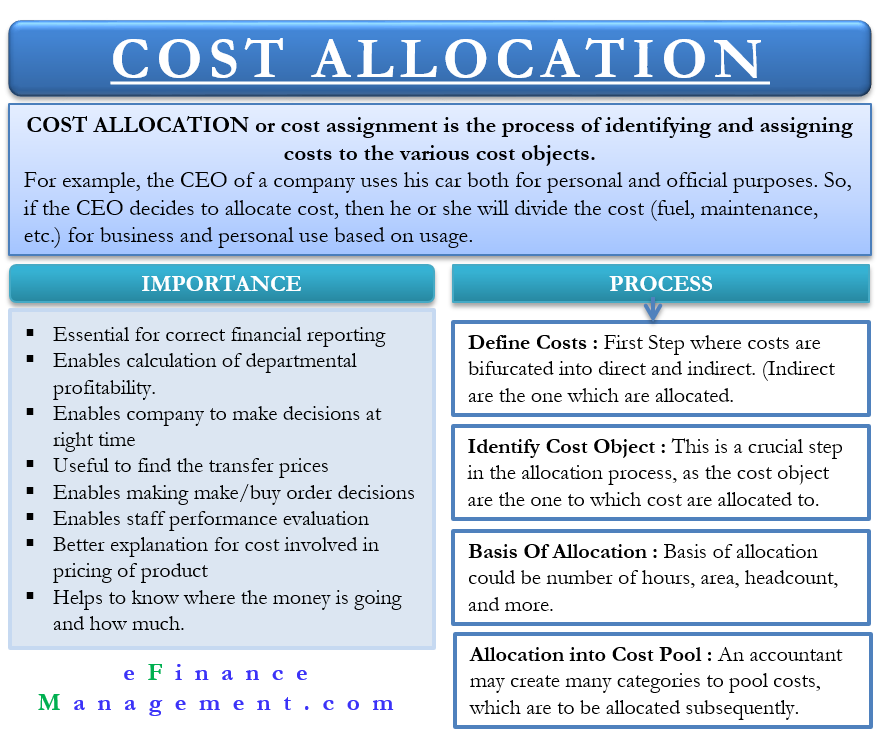
As such, there is no specific method to allocate costs. So, an accountant needs to use his or her due diligence to assign a cost to the cost object. Of course, they are considering the practice adopted in a similar industry. For instance, the accountant may decide to allocate expenses based on headcount, area, weightage, and so on.
Also Read: Cost Object – Meaning, Advantages, Types and More
Irrespective of the method an accountant uses, their objective should be to allocate the cost as fairly as possible. Or to allocate cost in a way that is in line with the nature of the cost object. Or to lower the arbitrariness in awarding costs.
Several efforts are underway to better cost allocation techniques. For instance, the overhead allocation for manufacturers, which was on plant-wide rates, is now based on departmental standards. Also, accountants use machine hours instead of direct labor hours for allocation.
Moreover, some accountants are also implementing activity-based costing to better the allocation. So, there can be several ways to allocate costs. But, whatever form the company selects, it is essential to document the reasons backing that method, and that need to be followed consistently for several periods.
A company can ensure documentation by developing allocation formulas or tables. Moreover, if a company wants, it can also pass supporting journal entries to transfer costs to the cost objects or do it via the chargeback module in the ERP system.
Also Read: Cost Hierarchy – Meaning, Levels and Example
Nowadays, cost allocation systems are available to assist in cost allocation. Such systems track the entity that produces the goods or services and the body that consumes those goods or services. The system also identifies the basis to distribute the cost.
The process to Allocate cost
As said above, there are no specific methods for allocating costs. Similarly, there is no particular process for it, as well. However, the process we are detailing is one of the most popular, and many companies use it for allocating costs. Following is the process:
Before allocating the cost, a company must define the various types of costs. Generally, there are three types of costs – direct, indirect, and overhead. Direct costs are those that one can easily attribute to a product or service, such as wages to factory workers or raw material for the specific product.
Indirect costs are ones that a company needs to incur for its operations, such as administration costs. Primarily, these are the costs that a company needs to allocate as it is difficult to attribute them directly to a product or service or any other cost object.
Another type of cost is an overhead cost , which is also an indirect cost. These costs are incurred for the production and selling of goods or services. Such costs do not vary based on production or sales. A company needs to pay them even if it is not producing or selling anything. Research and development costs, rent, etc., are good examples of such a cost.
The company or the accountant must know the cost objects for which they need to allocate the cost. It is crucial as we can’t assign costs to something on which we have no information. A cost object could be the product, customer, region, department, etc.
Along with the cost object , the company must also determine the basis on which it would allocate the cost. This basis could be the number of hours, area, headcount, and more. For example, if headcount is the basis of allocation for insurance costs and a company has 500 employees, then the department with 100 employees will account for 20% of the insurance cost. Experts recommend choosing a cost allocation base that is a crucial cost driver as well.
A cost driver is a variable whose increase or decrease leads to an increase or decrease in the cost as well. For instance, the number of purchase orders could be a cost driver for the cost of the purchasing department.
An accountant may create many categories to pool costs, which are to be allocated subsequently. It is the account head where the costs should be accumulated before assigning them to the cost objects. Cost pools can be insurance, fuel consumption, electricity, rent, depreciation, etc. The selection of the cost pool primarily depends on the use of the cost allocation base.
Continue reading – Costing Terms .
RELATED POSTS
- Cost Structure
- Types of Costs and their Classification
- Cost Accounting and Management Accounting
- Types of Cost Accounting
- Cost Accumulation: Meaning, Types, and More
- Types of Costing

Sanjay Bulaki Borad
MBA-Finance, CMA, CS, Insolvency Professional, B'Com
Sanjay Borad, Founder of eFinanceManagement, is a Management Consultant with 7 years of MNC experience and 11 years in Consultancy. He caters to clients with turnovers from 200 Million to 12,000 Million, including listed entities, and has vast industry experience in over 20 sectors. Additionally, he serves as a visiting faculty for Finance and Costing in MBA Colleges and CA, CMA Coaching Classes.
Leave a Comment Cancel reply
Save my name, email, and website in this browser for the next time I comment.
Sign me up for the newsletter!
Our Recommendations
- Best Small Business Loans for 2024
- Businessloans.com Review
- Biz2Credit Review
- SBG Funding Review
- Rapid Finance Review
- 26 Great Business Ideas for Entrepreneurs
- Startup Costs: How Much Cash Will You Need?
- How to Get a Bank Loan for Your Small Business
- Articles of Incorporation: What New Business Owners Should Know
- How to Choose the Best Legal Structure for Your Business
Small Business Resources
- Business Ideas
- Business Plans
- Startup Basics
- Startup Funding
- Franchising
- Success Stories
- Entrepreneurs
- The Best Credit Card Processors of 2024
- Clover Credit Card Processing Review
- Merchant One Review
- Stax Review
- How to Conduct a Market Analysis for Your Business
- Local Marketing Strategies for Success
- Tips for Hiring a Marketing Company
- Benefits of CRM Systems
- 10 Employee Recruitment Strategies for Success
- Sales & Marketing
- Social Media
- Best Business Phone Systems of 2024
- The Best PEOs of 2024
- RingCentral Review
- Nextiva Review
- Ooma Review
- Guide to Developing a Training Program for New Employees
- How Does 401(k) Matching Work for Employers?
- Why You Need to Create a Fantastic Workplace Culture
- 16 Cool Job Perks That Keep Employees Happy
- 7 Project Management Styles
- Women in Business
- Personal Growth
- Best Accounting Software and Invoice Generators of 2024
- Best Payroll Services for 2024
- Best POS Systems for 2024
- Best CRM Software of 2024
- Best Call Centers and Answering Services for Busineses for 2024
- Salesforce vs. HubSpot: Which CRM Is Right for Your Business?
- Rippling vs Gusto: An In-Depth Comparison
- RingCentral vs. Ooma Comparison
- Choosing a Business Phone System: A Buyer’s Guide
- Equipment Leasing: A Guide for Business Owners
- HR Solutions
- Financial Solutions
- Marketing Solutions
- Security Solutions
- Retail Solutions
- SMB Solutions
Business News Daily provides resources, advice and product reviews to drive business growth. Our mission is to equip business owners with the knowledge and confidence to make informed decisions. As part of that, we recommend products and services for their success.
We collaborate with business-to-business vendors, connecting them with potential buyers. In some cases, we earn commissions when sales are made through our referrals. These financial relationships support our content but do not dictate our recommendations. Our editorial team independently evaluates products based on thousands of hours of research. We are committed to providing trustworthy advice for businesses. Learn more about our full process and see who our partners are here .
What Is Cost Allocation?
Cost allocation is a process businesses use to identify costs. Here's everything you need to know.

Table of Contents
Entrepreneurs, small business owners and managers need accurate, timely financial data to run their operations. Specifically, understanding and connecting costs to items or departments helps them create budgets, develop strategies and make the best business decisions for their organizations. This is where cost allocation comes in. Detailed cost allocation reports help businesses ensure they’re charging enough to cover expenses and make a profit.
While a detailed cost allocation report may not be vital for extremely small businesses, more complex businesses require cost allocation to optimize profitability and productivity.
What is cost allocation?
Cost allocation is the process of identifying and assigning costs to business objects, such as products, projects, departments or individual company branches. Business owners use cost allocation to calculate profitability. Costs are separated or allocated, into different categories based on the business area they impact. These amounts are then used in accounting reports .
For example, say you’re a small clothing manufacturer. Your product line’s cost allocation would include materials, shipping and labor costs. It would also include a portion of the operation’s overhead costs. Calculating these costs consistently helps business leaders determine if profits from sales are higher than the costs of producing the product line. If not, it can help the owner pinpoint where to raise prices or cut expenses .
For a larger company, cost allocation is applied to each department or business location . Many companies also use cost allocation to determine annual bonuses for each area.
Types of costs
If you’re starting a business , the cost allocation process is relatively straightforward. However, larger businesses have many more costs that can be divided into two primary categories: direct and indirect costs:
- Purchased inventory
- Materials used to make inventory
- Direct labor costs for employees who make inventory
- Payroll for those who work in operations
- Manufacturing overhead, including rent, insurance and utilities costs
- Other overhead costs, including expenses that support the company but aren’t directly related to production, such as marketing and human resources
What is a cost driver?
A cost driver is a variable that affects business costs, such as the number of invoices issued, employee hours worked or units of electricity used. Unlike cost objects, such as units produced or departments, a cost driver reflects the reason for the incurred cost amounts.
How to allocate costs
While cost objects vary by business type, the cost allocation process is the same regardless of what your company produces. Here are the steps involved.
1. Identify your business’s cost objects.
Determine the cost objects to which you want to allocate costs, such as units of production, number of employees or departments. Remember that anything within your business that generates an expense is a cost object. Review each product line, project and department to ensure you’ve gathered all cost objects for which you must allocate costs.
2. Create a cost pool.
Next, create a detailed list of all business costs. Categories should cover utilities, business insurance policies, rent and any other expenses your business incurs.
3. Choose the best cost allocation method for your needs.
After identifying your business’s cost objects and creating a cost pool, you must choose a cost allocation method. Several methods exist, including the following standard ones:
- Direct materials cost method: This cost allocation method assumes all products have the same allocation base and variable rate.
- Direct labor cost method: This cost allocation method is most helpful if labor costs can be allocated to one product or if expenses vary directly with labor costs.
- High/low method. This cost allocation method is best if you have more than one cost driver and each driver has different fixed or variable rates.
- Step-up or step-down method: With this cost allocation method, departments are first ranked and then the cost of services is allocated from one service department to another in a series of steps.
- Full absorption costing (FAC): This cost allocation method combines direct material and direct labor costs with a predetermined FAC rate based on company historical data or industry standards.
- Variable costing: Consider this cost allocation method if your business has many variable cost allocations (costs that vary by quantity) and uses significant direct labor.
4. Allocate costs.
Now that you’ve listed cost objects, created a cost pool and chosen a cost allocation method, you’re ready to allocate costs.
Here’s a cost allocation example to help you visualize the process:
Dave owns a business that manufactures eyeglasses. In January, Dave’s overhead costs totaled $5,000. In the same month, he produced 3,000 eyeglasses with $2 in direct labor per product. Direct materials for each pair of eyeglasses totaled $5. Here’s what cost allocation would look like for Dave: Direct costs: $5 direct materials + $2 direct labor = $7 direct costs per pair Indirect costs: Overhead allocation: $5,000 ÷ 3,000 pairs = $1.66 overhead costs per pair Direct costs: $7 per pair + Indirect costs: $1.66 per pair Total cost: $8.66 per pair
As you can see, cost allocation helps Dave determine how much he must charge wholesale for each pair of eyeglasses to make a profit. Larger companies would apply this same process to each department and product to ensure sufficient sales goals.
5. Review and adjust cost allocations.
Cost allocations are never static. To be meaningful, they must be monitored and adjusted constantly as circumstances change.
What are the benefits of cost allocation?
Accurate, regular cost allocation can bring your business the following benefits:
- Helps you run your business: The information you glean from cost allocation reports helps you perform vital functions like preparing income tax returns and creating financial reports for investors, creditors and regulators.
- Informs business decisions: Cost allocation is an excellent business decision tool that can help you monitor productivity and justify expenses. Cost allocation gives a detailed overview of how your business expenses are used. From this perspective, you can determine which products and services are profitable and which departments are most productive.
- Helps produce accurate business reports: Tax accounting, financial accounting and management accounting all require some kind of cost allocation. This information is the foundation of accurate business reports.
- Can reveal accurate production costs: Knowing what it costs to create a product, including all expenses allocated to it, is essential to making good pricing decisions and allocating resources efficiently.
- Helps you evaluate staff: Cost allocation can help you assess the performance of different departments and staff members. If a department is not profitable, staff productivity may need improvement.
Common cost allocation mistakes
To get the most from cost allocation, avoid these common mistakes:
- Equal or inflexible allocation : Cost allocation is not as simple as allocating any given cost over different product lines or departments. Some cost objects require more time, expense or labor than others, for example.
- Missing costs: Costing is meaningless if it doesn’t include all expenses. Don’t forget costs, such as overhead, time spent and intangible expenses.
- Failing to adjust as needed: Costs and priorities in business are changing constantly. Be sure your cost allocations are monitored and adjusted to meet your information needs.
- Not considering fluctuating revenue with indirect costs: If your business is seasonal or fluctuates over time, it’s important to account for that when allocating costs.
Cost allocation and your business
Even if you operate a very small business, it’s essential to properly allocate your expenses. Otherwise, you could make all-too-common mistakes, such as charging too little for your product or spending too much on overhead. Whether you choose to start allocating costs on your own with software or with the help of a professional small business accountant , cost allocation is a process no business owner can afford to overlook.
Dachondra Cason contributed to this article.

Building Better Businesses
Insights on business strategy and culture, right to your inbox. Part of the business.com network.
Cost Allocation: Methods & Calculations for Improved Profitability

SHARE THIS ARTICLE
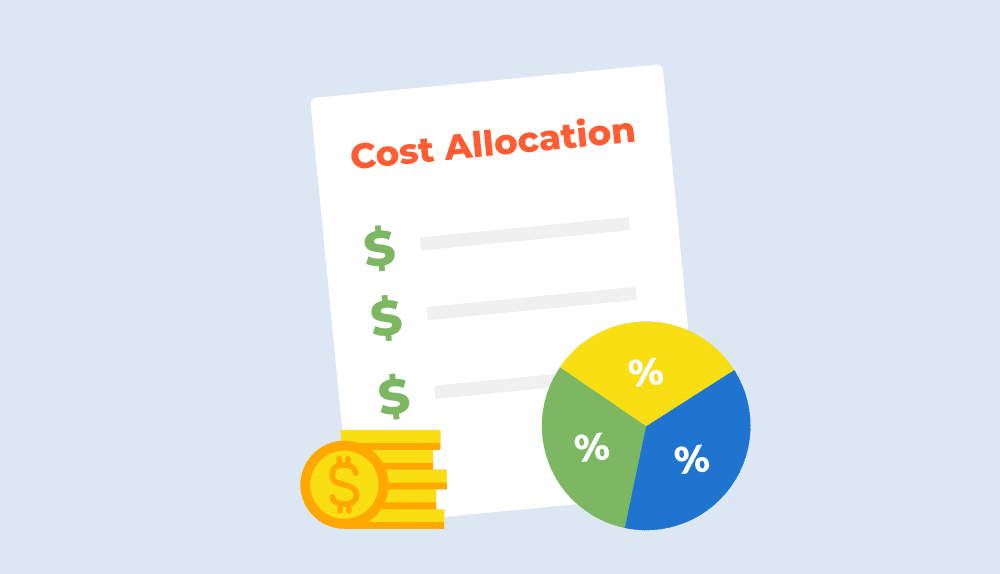
What was that invoice for and where did that other bill come from?
Unfortunately, for numerous professional services companies, these questions are asked way too often. Fortunately, there is one way to prevent this situation from happening — it’s called cost allocation .
After reading this article, you should be able to:
- Define cost allocation and the factors that affect it.
- Identify the cost objects that need to be taken into account in the process.
- Use the cost allocation formula and cost allocation method to assign expenditures to departments and projects with accuracy.
Cost Allocation Definition
Cost allocation is the process of matching the cost objects with the departments or operations that generate them. It is mostly used for calculating the financial performance of a company or its parts, such as teams or projects, and determining where given cost objects came from.
For example, in a typical services company, costs can be allocated to non-production departments (i.e. marketing, sales, administration), as well as projects and teams.
What is cost allocation used for?
What’s the point of calculating all of these things?
While cost allocation is very helpful when it’s time to sum up employee performance, results of particular project managers, or finances that may interest stakeholders, there are other perks.
On a daily basis, cost allocation can also help you:
- Ensure budgets are on track — both the budget of the entire company, as well as the finances of particular departments or projects.
- Identify the aspects of operations that generate excessive costs and act on that information.
- Check whether the company is spending money on the right endeavors.
In other words, cost allocation is the process of identifying the sources of the company’s costs and evaluating their importance.
Types of Costs in Cost Allocation
Cost allocation involves all the people and assets in the organization. Therefore, it includes dozens of different types of costs that project managers and executives need to take into consideration while managing project budgets and other finances.
Let’s take a look at the types of costs in cost allocation.
Basic Costs in Cost Allocation
In the simplest classification system possible, costs in a cost allocation are divided into 3 categories:
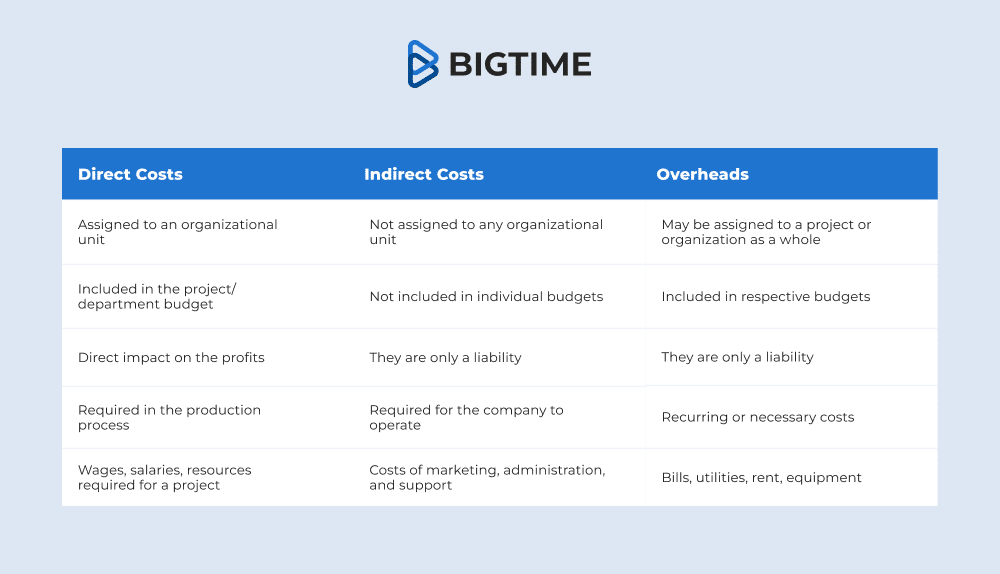
Direct Costs
Direct costs in cost allocation are spendings that have already been attributed to certain departments, projects, or teams, and there are no doubts as to their origin. These costs contribute to the profit billable operations are supposed to generate as they are required in the production processes.
For example, in a service company, direct costs are usually included in the project budget, or even a project timeline in general. They usually refer to wages and salaries, but they may also include other resources required for the project. Therefore, allocating this type of cost is a piece of cake, as they are generated directly by the department, services, or other cost objects they are related to.
Indirect Costs
The definition of indirect costs in cost allocation is a bit more complicated, especially for endeavors closely related to professional services. These costs are not associated with any organizational unit in particular; they are simply needed to keep the company running and growing.
Indirect costs usually include support staff wages and spendings made by the support staff that help the production department do its job. These include cost objects such as marketing and sales specialists, administrative employees, and any other support departments. Indirect costs also often include internal projects.
However, there is one more type of indirect cost in cost allocation that we need to consider — the overhead costs.
Overhead Costs
Overhead costs cover all the costs that need to be continually paid regardless of the company’s business performance.
Project Overheads vs Organizational Overheads
Overhead costs are usually divided into 2 categories:
- Project overheads, for example, equipment, subscriptions, and programs.
- Organizational overheads, such as utilities, bills, rent, etc.
- Cost of services needed to keep the company running, e.g. security expenses and business management.

Cost Allocation Method
At this point, you may ask yourself, “how can I allocate costs on my own?” Fortunately, the answer to this question is not as complicated as it may seem — here’s a cost allocation method that can help you.
Cost Allocation Method Example
Some organizations, particularly services companies, profit only from their projects, and they don’t need to allocate the costs for the entire business — they just need to share the costs between the profitable operations and departments, as well as other cost objects. Here’s what the process of identifying them looks like.
1. Define Which Costs You Want to Allocate
Begin by calculating the costs you want to allocate in the first place. For example, if you want to allocate the cost of utilities in your office, add them up to get a bigger picture.
For the sake of this cost allocation example, let’s assume that The Best Company is focused on allocating the costs of its support departments to the project for the month (also known as business overhead). The costs include:
- The costs of the marketing department: $40,000
- The costs of administration: $15,000
- The costs of the sales department: $45,000
Together, all these departments account for $100,000 of additional overhead expenses that need to be allocated.
2. Determine the Base for Sharing the Costs
Depending on the type of business, you can divide the costs based on different factors. The most popular ones include:
- Billable hours tracked in the services
- Generated income
- Generated profit
For this example, we’ll use the first of these indicators — billable hours. This method is considered the simplest way of allocating costs proportionally.
The Best Company has 2 projects — Project A and Project B.
To complete all the activities planned in Project A for the month, the project managers and their team members will need 1,800 hours. For Project B, the number of hours needed is 1,200. Both projects combined require 3,000 hours to complete. Therefore, Project A accounts for 60% of all billable hours in the company, while Project B includes 40% of them. These are the proportions we’re going to use in this cost allocation method.
3. Allocate the Costs Proportionally
If Project A includes 60% of all billable hours while Project B accounts for 40% of them, we can now use the numbers to determine the distribution of costs between them. Let’s focus on identifying how they should each contribute to costs.
According to the examples above, the total amount of costs to be shared among billable operations is $100,000. Project B requires more hours, therefore it should account for a larger chunk of the costs — exactly 60% of them. As a result, $60,000 of the costs are allocated to the project.
Project B, meanwhile, requires 40% of all the billable hours. Therefore, it should pay 40% of the costs — $40,000.
Benefits of Cost Allocation
While cost allocation is a burden, it’s also a huge business advantage.
With cost allocation, you can:
- Determine whether your projects are profitable.
- Learn what part each project plays in covering the organizational costs.
- Check whether the company’s rates are high enough to cover all the costs and generate profits.
- Determine whether indirect costs are eating up the majority of the company’s profits.
- Identify the actual cost of services you provide to your customers.
- Find out which departments are spending more or less money, and what they use it for.
- Assign any lost spending to the people, teams, or departments responsible for them.
- Calculate the real profitability of your business as a whole.

Ready to get started?
Recommended for you

Hindsight is 2020: Lessons learned and predictions for the PS industry
3 tips for more effective time tracking for consultants.

16 Years Later: Engineering Firm Founder Shares His 3 Secrets to Success
- Author: Erik Hooijer
- Date: 02-10-2023
The Art of Cost Allocation: Strategies for Effective Resource Distribution
Cost allocation is a crucial pillar of financial management. It governs how organizations assign costs to various departments, projects, or products to ensure transparency and accountability. Mastering the art of cost allocation can pave the way for better financial decision-making, resource distribution, and overall operational efficiency. This comprehensive guide will explore strategies to perfect this art, ensuring that your organization benefits from optimized resource distribution.
Understanding Cost Allocation
Before diving into the strategies, it’s imperative to grasp the concept of cost allocation. The term Cost Allocation is often used interchangeably with Activity Based Costing (ABC) is the process of distributing costs across multiple sectors or products within an organization. Cost allocation not only aids in understanding the true cost of a product or service, but also helps in pricing, budgeting, and overall financial management.
There are four different strategies to master the cost allocation process. We will explain them below.
- Direct Allocation : This is the most straightforward method of cost allocation which directly traces costs to specific departments or products. This method is most effective when the cost incurrence is clear-cut and directly linked to a particular segment.
- Step-down Allocation : Service departments allocate costs to operating departments in this method. Once a service department has allocated its costs, it no longer receives subsequent allocations. This method is sequential and follows a specific order.
- Reciprocal Allocation : This is for scenarios where inter-departmental services exist. Each department allocates costs to other departments and receives costs in return, making it the most comprehensive method.
- Activity-Based Costing (ABC): This modern approach allocates costs based on activities that consume resources. Identifying cost drivers (activities causing costs) provides a more accurate picture of cost allocation.
Factors to Consider in Cost Allocation
Causality in cost allocation is a fundamental factor that underscores the importance of assigning costs directly to their clear cause-and-effect relationship. This principle is critical for achieving fairness and accuracy in cost allocation processes.
Another factor is consistency. Consistency is pivotal in cost allocation, emphasizing stability and uniformity in the methods employed for assigning costs over time. Maintaining consistency in cost allocation practices is essential for preserving the comparability of financial data across different periods.
Traceability is a critical principle within cost management, emphasizing the necessity of being able to track costs back to their origin. This is essential for enhancing accountability and transparency within an organization’s financial operations. By ensuring you can trace back every cost to its source, organizations establish a transparent and auditable trail that promotes accountability among individuals and departments responsible for incurring costs.
Simplicity is another crucial consideration in cost allocation. While accuracy is undoubtedly important, it’s essential to strike a balance and avoid overly complex allocation methods that can become counterproductive. Aiming for simplicity in cost allocation processes makes them more manageable and understandable and ensures that the effort put into allocation doesn’t outweigh the benefits. Striving for this balance helps organizations streamline their financial operations while still achieving the necessary level of accuracy in cost assignment.
Benefits of Effective Cost Allocation
When used appropriately, cost allocation can sculpt an organization’s robust financial landscape. Some of the proven benefits are:
- Informed Decision-making: With a clear understanding of costs, management can make more informed operational and strategic decisions.
- Enhanced Accountability: Departments or projects bearing costs are more likely to use resources efficiently.`
- Accurate Pricing: Products or services can be priced more accurately when their true costs are understood.
- Improved Budgeting: Budgets can be set more realistically and effectively when costs are allocated correctly.
Avoiding Common Pitfalls
Missteps in cost allocation can distort financial insights significantly, and it’s crucial to avoid certain pitfalls. Over-generalization, where costs are allocated too broadly, can obscure the expenses associated with specific departments or products, leading to inaccurate assessments. Additionally, it’s essential not to disregard intangible costs, such as brand reputation, even though they are harder to quantify. These should still be incorporated into the allocation process for a more comprehensive view. Lastly, employing static approaches can be detrimental as the business environment evolves; it’s essential to regularly review and update cost allocation methods to ensure they remain relevant and reflective of current circumstances and needs.
Cost allocation is not merely a financial exercise; it’s an art. The strategies we’ve explored are tools that, when used appropriately, can sculpt a robust financial landscape for an organization. The art of cost allocation is all about ensuring that every dollar spent is accounted for, every resource is utilized optimally, and every financial decision is made with a crystal-clear understanding of its implications. By mastering these strategies and being aware of potential pitfalls, organizations can set a foundation for sustainable growth, profitability, and long-term success.
Note Terms like Cost Allocation can be often interchangeably with others. If you hear someone using a term like Cost Modeling, Cost Management, A ctivity Based Costing (ABC), don’t sweat the difference. People and companies will have their own preferred term, but here at CostPerform, we often used Cost Allocation.
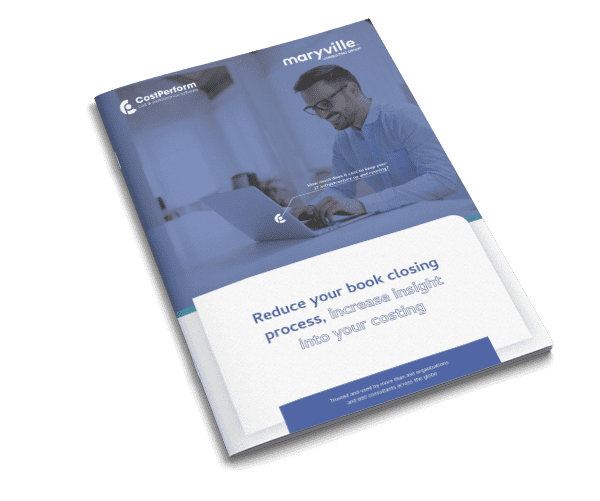
Are you ready for a 1 to 2-day reduction on your monthly book close process?
Download our white paper on corporate allocations, developed in collaboration with maryville consulting group..
+1 410 385 5325 [email protected]
CostPerform The Netherlands
+31 (0) 85 023 2114 [email protected] ACADEMY SUPPORT
- Time-driven Activity-Based Costing
- Capacity Management
- Multi-dimensional costing
- Technology Business Management
- Regulatory reporting
- Customer profitability
- Financial Institution
- IT services
- Manufacturing and Logistics
- Download brochure
- Online demo
- Download price list
- Become a partner
- Support Center
- Subscribe to our newsletter
ISO 27001 certified
© costperform 2024 | privacy policy | cookie statement | cookie preferences | terms of use.
Exercise Set B
LO 10.1 Calculate the goods available for sale for Soros Company, in units and in $ (dollar amounts), given the following facts about their inventory for the period.
LO 10.1 X Company accepts goods on consignment from C Company, and also purchases goods from P Company during the current month. X Company plans to sell the merchandise to customers during the following month. In each of these independent situations, who owns the merchandise at the end of the current month, and should therefore include it in their company’s ending inventory? Choose X, C, or P.
- Goods ordered from P, in transit, with shipping terms FOB destination.
- Goods ordered from P, in transit, with shipping terms FOB shipping point.
- Goods ordered from P, inventory in stock, held in storage until floor space is available.
- Goods ordered from C, inventory in stock, set aside for customer pickup and payments to finalize sale.
LO 10.1 Considering the following information, and applying the lower-of-cost-or-market approach, what is the correct value that should be reported on the balance sheet for the inventory?
LO 10.2 Complete the missing piece of information involving the changes in inventory, and their relationship to goods available for sale, for the two years shown.
LO 10.2 Bleistine Company had the following transactions for the month.
Calculate the ending inventory dollar value for each of the following cost allocation methods, using periodic inventory updating. Provide your calculations.
- first-in, first-out (FIFO)
- last-in, first-out (LIFO)
- weighted average (AVG)
Calculate the gross margin for the period for each of the following cost allocation methods, using periodic inventory updating. Assume that all units were sold for $50 each. Provide your calculations.
LO 10.2 Prepare journal entries to record the following transactions, assuming periodic inventory updating and first-in, first-out (FIFO) cost allocation.
LO 10.3 Calculate the cost of goods sold dollar value for B65 Company for the month, considering the following transactions under three different cost allocation methods and using perpetual inventory updating. Provide calculations for first-in, first-out (FIFO).
LO 10.3 Calculate the cost of goods sold dollar value for B66 Company for the month, considering the following transactions under three different cost allocation methods and using perpetual inventory updating. Provide calculations for last-in, first-out (LIFO).
LO 10.3 Calculate the cost of goods sold dollar value for B67 Company for the month, considering the following transactions under three different cost allocation methods and using perpetual inventory updating. Provide calculations for weighted average (AVG).
LO 10.3 Prepare journal entries to record the following transactions, assuming perpetual inventory updating and first-in, first-out (FIFO) cost allocation. Assume no beginning inventory.
LO 10.3 Prepare journal entries to record the following transactions, assuming perpetual inventory updating and last-in, first-out (LIFO) cost allocation. Assume no beginning inventory.
LO 10.4 If a group of inventory items costing $3,200 had been double counted during the year-end inventory count, what impact would the error have on the following inventory calculations? Indicate the effect (and amount) as either (a) none, (b) understated $______, or (c) overstated $______.
| Inventory Item | None or amount? | Understated or overstated? |
|---|---|---|
| Beginning Inventory | ||
| Purchases | ||
| Goods Available for Sale | ||
| Ending Inventory | ||
| Cost of Goods Sold |
LO 10.4 If Barcelona Company’s ending inventory was actually $122,000, but the cost of consigned goods, with a cost value of $20,000 were accidentally included with the company assets, when making the year-end inventory adjustment, what would be the impact on the presentation of the balance sheet and income statement for the year that the error occurred, if any?
LO 10.4 Tanke Company reported net income on the year-end financial statements of $850,200. However, errors in inventory were discovered after the reports were issued. If inventory was overstated by $21,000, how much net income did the company actually earn?
LO 10.5 Compute Westtown Company’s (A) inventory turnover ratio and (B) number of days’ sales in inventory ratio, using the following information.
LO 10.5 Complete the missing pieces of Delgado Company’s inventory calculations and ratios.
As an Amazon Associate we earn from qualifying purchases.
This book may not be used in the training of large language models or otherwise be ingested into large language models or generative AI offerings without OpenStax's permission.
Want to cite, share, or modify this book? This book uses the Creative Commons Attribution-NonCommercial-ShareAlike License and you must attribute OpenStax.
Access for free at https://openstax.org/books/principles-financial-accounting/pages/1-why-it-matters
- Authors: Mitchell Franklin, Patty Graybeal, Dixon Cooper
- Publisher/website: OpenStax
- Book title: Principles of Accounting, Volume 1: Financial Accounting
- Publication date: Apr 11, 2019
- Location: Houston, Texas
- Book URL: https://openstax.org/books/principles-financial-accounting/pages/1-why-it-matters
- Section URL: https://openstax.org/books/principles-financial-accounting/pages/10-exercise-set-b
© Dec 13, 2023 OpenStax. Textbook content produced by OpenStax is licensed under a Creative Commons Attribution-NonCommercial-ShareAlike License . The OpenStax name, OpenStax logo, OpenStax book covers, OpenStax CNX name, and OpenStax CNX logo are not subject to the Creative Commons license and may not be reproduced without the prior and express written consent of Rice University.
Cost Allocation
The process of identifying, accumulating, and assigning costs to costs objects
What is Cost Allocation?
Cost allocation is the process of identifying, accumulating, and assigning costs to costs objects such as departments, products, programs, or a branch of a company. It involves identifying the cost objects in a company, identifying the costs incurred by the cost objects, and then assigning the costs to the cost objects based on specific criteria.
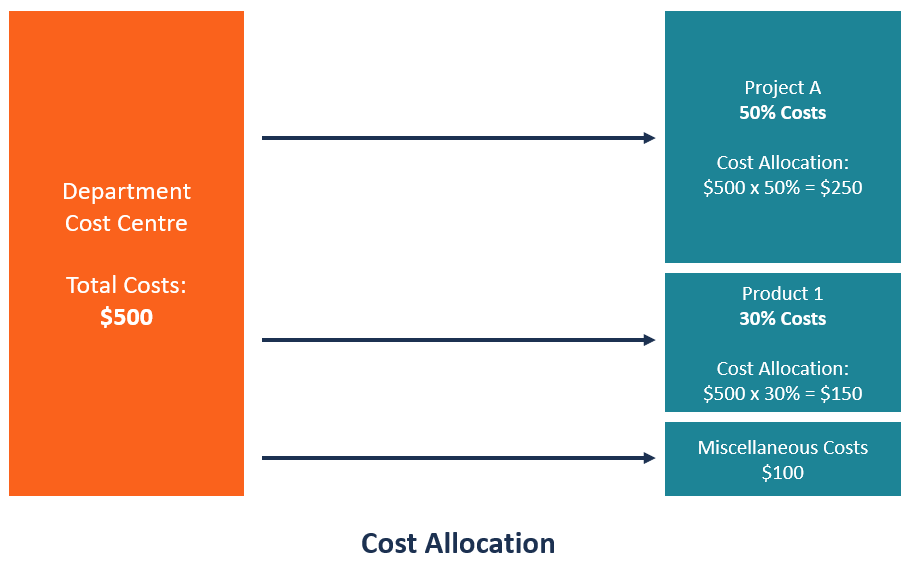
When costs are allocated in the right way, the business is able to trace the specific cost objects that are making profits or losses for the company. If costs are allocated to the wrong cost objects, the company may be assigning resources to cost objects that do not yield as much profits as expected.
Types of Costs
There are several types of costs that an organization must define before allocating costs to their specific cost objects. These costs include:
1. Direct costs
Direct costs are costs that can be attributed to a specific product or service, and they do not need to be allocated to the specific cost object. It is because the organization knows what expenses go to the specific departments that generate profits and the costs incurred in producing specific products or services . For example, the salaries paid to factory workers assigned to a specific division is known and does not need to be allocated again to that division.
2. Indirect costs
Indirect costs are costs that are not directly related to a specific cost object like a function, product, or department. They are costs that are needed for the sake of the company’s operations and health. Some common examples of indirect costs include security costs, administration costs, etc. The costs are first identified, pooled, and then allocated to specific cost objects within the organization.
Indirect costs can be divided into fixed and variable costs. Fixed costs are costs that are fixed for a specific product or department. An example of a fixed cost is the remuneration of a project supervisor assigned to a specific division. The other category of indirect cost is variable costs, which vary with the level of output. Indirect costs increase or decrease with changes in the level of output.
3. Overhead costs
Overhead costs are indirect costs that are not part of manufacturing costs. They are not related to the labor or material costs that are incurred in the production of goods or services. They support the production or selling processes of the goods or services. Overhead costs are charged to the expense account, and they must be continually paid regardless of whether the company is selling goods or not.
Some common examples of overhead costs are rental expenses, utilities, insurance, postage and printing, administrative and legal expenses , and research and development costs.
Cost Allocation Mechanism
The following are the main steps involved when allocating costs to cost objects:
1. Identify cost objects
The first step when allocating costs is to identify the cost objects for which the organization needs to separately estimate the associated cost. Identifying specific cost objects is important because they are the drivers of the business, and decisions are made with them in mind.
The cost object can be a brand , project, product line, division/department, or a branch of the company. The company should also determine the cost allocation base, which is the basis that it uses to allocate the costs to cost objects.
2. Accumulate costs into a cost pool
After identifying the cost objects, the next step is to accumulate the costs into a cost pool, pending allocation to the cost objects. When accumulating costs, you can create several categories where the costs will be pooled based on the cost allocation base used. Some examples of cost pools include electricity usage, water usage, square footage, insurance, rent expenses , fuel consumption, and motor vehicle maintenance.
What is a Cost Driver?
A cost driver causes a change in the cost associated with an activity. Some examples of cost drivers include the number of machine-hours, the number of direct labor hours worked, the number of payments processed, the number of purchase orders, and the number of invoices sent to customers.
Benefits of Cost Allocation
The following are some of the reasons why cost allocation is important to an organization:
1. Assists in the decision-making process
Cost allocation provides the management with important data about cost utilization that they can use in making decisions. It shows the cost objects that take up most of the costs and helps determine if the departments or products are profitable enough to justify the costs allocated. For unprofitable cost objects, the company’s management can cut the costs allocated and divert the money to other more profitable cost objects.
2. Helps evaluate and motivate staff
Cost allocation helps determine if specific departments are profitable or not. If the cost object is not profitable, the company can evaluate the performance of the staff members to determine if a decline in productivity is the cause of the non-profitability of the cost objects.
On the other hand, if the company recognizes and rewards a specific department for achieving the highest profitability in the company, the employees assigned to that department will be motivated to work hard and continue with their good performance.
Additional Resources
Thank you for reading CFI’s guide to Cost Allocation. In order to help you become a world-class financial analyst and advance your career to your fullest potential, these additional resources will be very helpful:
- Break-Even Analysis
- Cost of Production
- Fixed and Variable Costs
- Projecting Income Statement Line Items
- See all accounting resources

- Share this article

Create a free account to unlock this Template
Access and download collection of free Templates to help power your productivity and performance.
Already have an account? Log in
Supercharge your skills with Premium Templates
Take your learning and productivity to the next level with our Premium Templates.
Upgrading to a paid membership gives you access to our extensive collection of plug-and-play Templates designed to power your performance—as well as CFI's full course catalog and accredited Certification Programs.
Already have a Self-Study or Full-Immersion membership? Log in
Access Exclusive Templates
Gain unlimited access to more than 250 productivity Templates, CFI's full course catalog and accredited Certification Programs, hundreds of resources, expert reviews and support, the chance to work with real-world finance and research tools, and more.
Already have a Full-Immersion membership? Log in
What is the Cost Allocation? (Definition, Example, and How the Cost Allocation Works)
Cost allocation, direct cost allocation, indirect cost, steps of cost allocation, 1- cost identification, 2- identify the basis of allocation, 3- cost allocation, examples of cost allocation, 1- transparency, 2- decision making, 3- waste reduction, 4- enhanced reporting, limitations, process complications, traditional vs. abc system of cost allocation, related posts, 4 best account payable books of all time – recommended, what are the purposes of budgeting, just-in-time: history, objective, productions, and purchasing, absorption costing: definition, formula, calculation, and example.

Cost Allocation

Written by True Tamplin, BSc, CEPF®
Reviewed by subject matter experts.
Updated on June 08, 2023
Get Any Financial Question Answered
Table of contents.
Cost allocation is a process in which businesses and individuals identify the costs incurred by activity and distribute them to appropriate accounts .
This allows for better decision-making when determining how much should be spent on different business areas.
Types of Costs
There are types of costs to consider during the process of cost allocation. They include:
- Fixed costs . These are expenses that remain the same no matter how many units of production have been made or sold. For example, a business spends $100,000 on rent every month. Even if the company can only produce and sell 50 units of a product in one month (when they normally make and sell 100), this cost remains at $100,000 for that given time period.
- Variable costs . These expenses depend on the amount of production or sales made within a given period, such as raw materials used for making products. For example, it costs a furniture shop $50 to make a chair—$20 for raw materials such as wood, cane, metal, leather, and fabrics, and $30 for the direct labor involved in making one chair.
Below shows how the variable costs change as the number of chairs made varies.

As the production output of chairs increases, the bakery’s variable costs also increase. When the furniture shop does not make any chair, its variable costs drop to zero.
- Indirect costs . These are expenses that cannot be directly linked to the making or selling of goods or services, such as administrative salaries, office expenses, security expenses, and utilities.
- Direct Costs. These are costs that can be directly linked to the making or selling of goods or services. For example, if a company pays for equipment rental to produce their product, this cost is considered direct because it links back to how many units have been produced.
Why Is Cost Allocation Important?
Cost allocation is an important part of any business. The following points reflect why you should always be sure to allocate all your expenses:
- It helps in accurate decision-making. When costs are known, it is easier to determine which strategies will most benefit the business or individual.
- Allocating cost enables comparison between different products and services.
For example, comparing the cost of producing one product versus another can help decide which should be produced more often based on its profitability compared with other goods or services offered by a company.
- It helps in understanding which departments are more profitable than others. Identifying the cost of different areas of business allows for better decision-making at the departmental level, and overall.
- It can help identify problem areas within a company to allow for improvements or changes that might be beneficial for future production or sales.
Taking these factors into account when allocating cost allows businesses and individuals to understand better how much money they need coming in (revenue) compared with how much they must spend (costs).
This makes setting prices easier since there is an understanding of what each unit sold brings in revenue-wise.
Common Mistakes People Make When Allocating Costs
- Not accounting for overhead . Overhead is a general term that refers to indirect expenses, which are not directly attributed to the cost of goods sold (COGS) or fixed costs.
- Not taking into account which projects are currently generating revenue and which ones aren’t.
- Not allocating indirect expenses equally among departments and projects within a company.
- Not considering how fluctuating revenue affects indirect expenses. If you’re seeing a lot of variability in revenue over time, you need to account for that when allocating costs.
- Using the incorrect allocation method. There are many different methods for allocating costs and using more than one can help you get a better idea of where your business is spending its money.
Process of Cost Allocation
The following is an overview of how to allocate costs and some tips on what you should take into consideration when doing so.
Step One: Identify Your Costs
The first step is to identify all of your costs. This includes both direct and indirect expenses, as well as fixed or variable costs.
Step Two: Allocate Indirect Costs Between Departments or Products
Indirect costs should be allocated between departments, projects, and products based on a fair allocation plan that reflects their use in those areas.
For example, suppose your company produces two products, products A and B.
In that case, you will need to construct a cost-allocation plan that reflects the allocation of overhead expenses between these areas.
Step Three: Allocate Fixed Costs Among Departments or Projects
Fixed costs are allocated among departments or projects based on how they benefit each area.
For example, if Product A produces a specific product that is used for Product B, it would be appropriate to allocate the fixed costs associated with producing Product A between these two products.
Step Four: Allocate Variable Costs Among Departments or Projects
Variable costs are allocated among departments or projects based on how much of each cost driver they use.
For example, if your company produces two products, A and B (and each product has its own direct labor cost), you would first need to determine how many units of Product A are produced for every unit of Product B sold.
You can then use this information to allocate the variable costs associated with producing each product based on their respective rates.
Step Five: Use Cost-Volume-Profit Analysis to Determine the Best Allocation Method
If your company uses multiple products, services, or departments that incur indirect costs, cost allocation is important in determining which method will work best for reporting profits accurately.
For example, suppose you’re using a full absorption costing (FAC) system and another department within your company is using a direct labor cost system.
In that case, you may need to use more than one allocation method.
Step Six: Use Cost Allocation for Decision Making & Reporting
Cost allocation is important for both decision-making and reporting purposes.
Using cost allocation, you can determine which areas of your company are over or under-spending and how changes to specific processes will affect the overall profitability of a product or department.
Common Cost Allocation Methods
Cost allocation faqs, what is cost allocation.
Cost allocation is the process of assigning expenses to one or more cost objects. A cost object can be a product, project, department, business unit, or another grouping within an organization with costs associated with it.
How is cost allocation done?
There are many ways to allocate expenses, including the high/low method and step-up/down. There’s also a simple way called the direct materials cost method that uses an allocation base of the same value as the variable rate. Using FAC or Variable costing can provide more accurate reporting on your company’s financials.
What are the benefits of cost allocation?
Cost allocation allows you to determine where costs can be reduced and provides accurate reporting on company financials based on its relative performance. Allocating indirect expenses is also important for decision-making purposes. With this information, you can determine which areas of your business need improvement and how changes in production will affect overall profitability. Cost allocation can also show you which departments or products are spending too much money on indirect expenses, and which ones aren’t using enough of them. This enables you to make more informed staffing decisions in the future based on how your company’s needs change over time. Finally, cost allocation allows companies to compare their performance against similar businesses.
What are common mistakes people make when allocating costs?
One of the most common mistakes is to allocate indirect expenses based on current production volume. Other issues include not performing cost allocation at all or using arbitrary rates rather than industry standards. When deciding how to allocate these types of expenses, companies should consider their company’s size and what it will cost to produce a certain amount of output.
How is cost allocation performed?
Cost allocation can be done manually or through software. It’s important to keep detailed records of all your company’s expenses so you have accurate financial reports for decision-making purposes. If you don’t have cost records, the process of allocation can be time-consuming and difficult to determine. You may not know which department or product each expense is associated with, so your reports will lack accuracy.

About the Author
True Tamplin, BSc, CEPF®
True Tamplin is a published author, public speaker, CEO of UpDigital, and founder of Finance Strategists.
True is a Certified Educator in Personal Finance (CEPF®), author of The Handy Financial Ratios Guide , a member of the Society for Advancing Business Editing and Writing, contributes to his financial education site, Finance Strategists, and has spoken to various financial communities such as the CFA Institute, as well as university students like his Alma mater, Biola University , where he received a bachelor of science in business and data analytics.
To learn more about True, visit his personal website or view his author profiles on Amazon , Nasdaq and Forbes .
Related Topics
- Cost Allocation Base
- Cost Application
Ask a Financial Professional Any Question
We use cookies to ensure that we give you the best experience on our website. If you continue to use this site we will assume that you are happy with it.
Fact Checked
At Finance Strategists, we partner with financial experts to ensure the accuracy of our financial content.
Our team of reviewers are established professionals with decades of experience in areas of personal finance and hold many advanced degrees and certifications.
They regularly contribute to top tier financial publications, such as The Wall Street Journal, U.S. News & World Report, Reuters, Morning Star, Yahoo Finance, Bloomberg, Marketwatch, Investopedia, TheStreet.com, Motley Fool, CNBC, and many others.
This team of experts helps Finance Strategists maintain the highest level of accuracy and professionalism possible.
Why You Can Trust Finance Strategists
Finance Strategists is a leading financial education organization that connects people with financial professionals, priding itself on providing accurate and reliable financial information to millions of readers each year.
We follow strict ethical journalism practices, which includes presenting unbiased information and citing reliable, attributed resources.
Our goal is to deliver the most understandable and comprehensive explanations of financial topics using simple writing complemented by helpful graphics and animation videos.
Our writing and editorial staff are a team of experts holding advanced financial designations and have written for most major financial media publications. Our work has been directly cited by organizations including Entrepreneur, Business Insider, Investopedia, Forbes, CNBC, and many others.
Our mission is to empower readers with the most factual and reliable financial information possible to help them make informed decisions for their individual needs.
How It Works
Step 1 of 3, ask any financial question.
Ask a question about your financial situation providing as much detail as possible. Your information is kept secure and not shared unless you specify.

Step 2 of 3
Our team will connect you with a vetted, trusted professional.
Someone on our team will connect you with a financial professional in our network holding the correct designation and expertise.

Step 3 of 3
Get your questions answered and book a free call if necessary.
A financial professional will offer guidance based on the information provided and offer a no-obligation call to better understand your situation.

Where Should We Send Your Answer?

Just a Few More Details
We need just a bit more info from you to direct your question to the right person.
Tell Us More About Yourself
Is there any other context you can provide.
Pro tip: Professionals are more likely to answer questions when background and context is given. The more details you provide, the faster and more thorough reply you'll receive.
What is your age?
Are you married, do you own your home.
- Owned outright
- Owned with a mortgage
Do you have any children under 18?
- Yes, 3 or more
What is the approximate value of your cash savings and other investments?
- $50k - $250k
- $250k - $1m
Pro tip: A portfolio often becomes more complicated when it has more investable assets. Please answer this question to help us connect you with the right professional.
Would you prefer to work with a financial professional remotely or in-person?
- I would prefer remote (video call, etc.)
- I would prefer in-person
- I don't mind, either are fine
What's your zip code?
- I'm not in the U.S.

Submit to get your question answered.
A financial professional will be in touch to help you shortly.

Part 1: Tell Us More About Yourself
Do you own a business, which activity is most important to you during retirement.
- Giving back / charity
- Spending time with family and friends
- Pursuing hobbies
Part 2: Your Current Nest Egg
Part 3: confidence going into retirement, how comfortable are you with investing.
- Very comfortable
- Somewhat comfortable
- Not comfortable at all
How confident are you in your long term financial plan?
- Very confident
- Somewhat confident
- Not confident / I don't have a plan
What is your risk tolerance?
How much are you saving for retirement each month.
- None currently
- Minimal: $50 - $200
- Steady Saver: $200 - $500
- Serious Planner: $500 - $1,000
- Aggressive Saver: $1,000+
How much will you need each month during retirement?
- Bare Necessities: $1,500 - $2,500
- Moderate Comfort: $2,500 - $3,500
- Comfortable Lifestyle: $3,500 - $5,500
- Affluent Living: $5,500 - $8,000
- Luxury Lifestyle: $8,000+
Part 4: Getting Your Retirement Ready
What is your current financial priority.
- Getting out of debt
- Growing my wealth
- Protecting my wealth
Do you already work with a financial advisor?
Which of these is most important for your financial advisor to have.
- Tax planning expertise
- Investment management expertise
- Estate planning expertise
- None of the above
Where should we send your answer?
Submit to get your retirement-readiness report., get in touch with, great the financial professional will get back to you soon., where should we send the downloadable file, great hit “submit” and an advisor will send you the guide shortly., create a free account and ask any financial question, learn at your own pace with our free courses.
Take self-paced courses to master the fundamentals of finance and connect with like-minded individuals.
Get Started
To ensure one vote per person, please include the following info, great thank you for voting., get in touch, submit your info below and someone will get back to you shortly..
To read this content please select one of the options below:
Please note you do not have access to teaching notes, cost allocation: what purpose does it serve.
Managerial Auditing Journal
ISSN : 0268-6902
Article publication date: 1 November 1996
Regardless of the approach taken to allocating common costs, is cost allocation really necessary? Argues that such an exercise may not make any difference to the final outcome ‐ the company’s final profit or loss figure. Takes as an example the University of Clemson, USA’s system of costing and reporting, and describes the university’s Finance Committee’s challenge to that system.
- Cost allocation
- Financial statements
- Universities
Doost, R.K. (1996), "Cost allocation: what purpose does it serve?", Managerial Auditing Journal , Vol. 11 No. 8, pp. 14-22. https://doi.org/10.1108/02686909610131648
Copyright © 1996, MCB UP Limited
Related articles
All feedback is valuable.
Please share your general feedback
Report an issue or find answers to frequently asked questions
Contact Customer Support

In order to continue enjoying our site, we ask that you confirm your identity as a human. Thank you very much for your cooperation.
- Cost Classifications
- Relevant Cost of Material
- Manufacturing Overhead Costs
- Conversion Costs
- Quality Costs
- Revenue Expenditure
- Product Cost vs Period Cost
- Direct Costs and Indirect Costs
- Prime Costs and Conversion Costs
- Relevant vs Irrelevant Costs
- Avoidable and Unavoidable Costs
- Cost Allocation
- Joint Products
- Accounting for Joint Costs
- Service Department Cost Allocation
- Repeated Distribution Method
- Simultaneous Equation Method
- Specific Order of Closing Method
- Direct Allocation Method
Cost allocation is the process by which the indirect costs are distributed among different cost objects such as a project, a department, a branch, a customer, etc. It involves identifying the cost object, identifying and accumulating the costs that are incurred and assigning them to the cost object on some reasonable basis.
Cost allocation is important for both pricing and planning and control decisions. If costs are not accurately calculated, a business might never know which products are making money and which ones are losing money. If cost are mis-allocated, a business may be charging wrong price to its customers and/or it might be wasting resources on products that are wrongly categorized as profitable.
Cost allocation is a sub-process of cost assignment , which is the overall process of finding total cost of a cost object. Cost assignment involves both cost tracing and cost allocation. Cost tracing encompasses finding direct costs of a cost object while the cost allocation is concerned with indirect cost charge.
Steps in cost allocation process
Typical cost allocation mechanism involves:
- Identifying the object to which the costs have to be assigned,
- Accumulating the costs in different pools,
- Identifying the most appropriate basis/method for allocating the cost.
Cost object
A cost object is an item for which a business need to separately estimate cost.
Examples of cost object include a branch, a product line, a service line, a customer, a department, a brand, a project, etc.
A cost pool is the account head in which costs are accumulated for further assignment to cost objects.
Examples of cost pools include factory rent, insurance, machine maintenance cost, factory fuel, etc. Selection of cost pool depends on the cost allocation base used. For example if a company uses just one allocation base say direct labor hours, it might use a broad cost pool such as fixed manufacturing overheads. However, if it uses more specific cost allocation bases, for example labor hours, machine hours, etc. it might define narrower cost pools.
Cost driver
A cost driver is any variable that ‘drives’ some cost. If increase or decrease in a variable causes an increase or decrease is a cost that variable is a cost driver for that cost.
Examples of cost driver include:
- Number of payments processed can be a good cost driver for salaries of Accounts Payable section of accounting department,
- Number of purchase orders can be a good cost driver for cost of purchasing department,
- Number of invoices sent can be a good cost driver for cost of billing department,
- Number of units shipped can be a good cost driver for cost of distribution department, etc.
While direct costs are easily traced to cost objects, indirect costs are allocated using some systematic approach.
Cost allocation base
Cost allocation base is the variable that is used for allocating/assigning costs in different cost pools to different cost objects. A good cost allocation base is something which is an appropriate cost driver for a particular cost pool.
T2F is a university café owned an operated by a student. While it has plans for expansion it currently offers two products: (a) tea & coffee and (b) shakes. It employs 2 people: Mr. A, who looks after tea & coffee and Mr. B who prepares and serves shakes & desserts.
Its costs for the first quarter are as follows:
| Mr. A salary | 16,000 |
| Mr. B salary | 12,000 |
| Rent | 10,000 |
| Electricity | 8,000 |
| Direct materials consumed in making tea & coffee | 7,000 |
| Direct raw materials for shakes | 6,000 |
| Music rentals paid | 800 |
| Internet & wi-fi subscription | 500 |
| Magazines | 400 |
Total tea and coffee sales and shakes sales were $50,000 & $60,000 respectively. Number of customers who ordered tea or coffee were 10,000 while those ordering shakes were 8,000.
The owner is interested in finding out which product performed better.
Salaries of Mr. A & B and direct materials consumed are direct costs which do not need any allocation. They are traced directly to the products. The rest of the costs are indirect costs and need some basis for allocation.
Cost objects in this situation are the products: hot beverages (i.e. tea & coffee) & shakes. Cost pools include rent, electricity, music, internet and wi-fi subscription and magazines.
Appropriate cost drivers for the indirect costs are as follows:
| Rent | 10,000 | Number of customers |
| Electricity | 8,000 | United consumed by each product |
| Music rentals paid | 800 | Number of customers |
| Internet & wifi subscription | 500 | Number of customers |
| Magazines | 400 | Number of customers |
| 19,700 |
Since number of customers is a good cost driver for almost all the costs, the costs can be accumulated together to form one cost pool called manufacturing overheads. This would simply the cost allocation.
Total manufacturing overheads for the first quarter are $19,700. Total number of customers who ordered either product are 18,000. This gives us a cost allocation base of $1.1 per customer ($19,700/18,000).
A detailed cost assignment is as follows:
| Tea & Coffee | Shakes | |
| Revenue | 50,000 | 60,000 |
| Costs: | ||
| Salaries | 16,000 | 12,000 |
| Direct materials | 7,000 | 6,000 |
| Manufacturing overheads allocated | 11,000 | 8,800 |
| Total costs | 34,000 | 26,800 |
| Profit earned | 16,000 | 33,200 |
Manufacturing overheads allocated to Tea & Cofee = $1.1×10,000
Manufacturing overheads allocated to Shakes = $1.1×8,000
by Irfanullah Jan, ACCA and last modified on Jul 22, 2020
Related Topics
- Cost Behavior
All Chapters in Accounting
- Intl. Financial Reporting Standards
- Introduction
- Accounting Principles
- Business Combinations
- Accounting Cycle
- Financial Statements
- Non-Current Assets
- Fixed Assets
- Investments
- Revenue Recognition
- Current Assets
- Receivables
- Inventories
- Shareholders' Equity
- Liability Accounts
- Accounting for Taxes
- Employee Benefits
- Accounting for Partnerships
- Financial Ratios
- Cost Accounting Systems
- CVP Analysis
- Relevant Costing
- Capital Budgeting
- Master Budget
- Inventory Management
- Cash Management
- Standard Costing
Current Chapter
XPLAIND.com is a free educational website; of students, by students, and for students. You are welcome to learn a range of topics from accounting, economics, finance and more. We hope you like the work that has been done, and if you have any suggestions, your feedback is highly valuable. Let's connect!
Copyright © 2010-2024 XPLAIND.com
Article Categories
Book categories, collections.
- Business, Careers, & Money Articles
- Business Articles
- Accounting Articles
- General Accounting Articles
The Step-Down Allocation Method in Cost Accounting
Cost accounting for dummies.
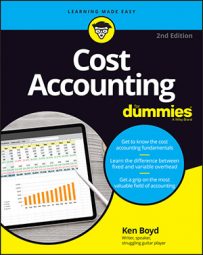
Sign up for the Dummies Beta Program to try Dummies' newest way to learn.
When cost accounting, the step-down allocation method allows support departments to allocate costs to each other — and ultimately to the operating departments. To accomplish this, the support departments are ranked. The ranking is often based on the percentage of costs that a support department incurs to support other support departments.
The support department with the highest percentage is allocated first. All of its costs are allocated out — whether to an operating department or to another support department. After that, the support department with the second-highest percentage is allocated. Step by step, the costs for each support department are fully allocated. In the end, the calculation “goes flat,” because all costs are allocated.
Your company has both a human resources (HR) department and a legal department which support two operating departments: assembly and shipping. Say $10,000 of the human resources cost is allocated to the legal department. Legal doesn’t allocate any costs to human resources. So you rank the HR department higher than legal. That’s because HR allocates support costs to another support department and legal doesn’t. This table shows that allocation.
| Legal | Assembly | Shipping | ||
|---|---|---|---|---|
| Beginning balance | $300,000 | $1,000,000 | $75,000 | |
| HR cost allocation | ||||
| $100,000 | $10,000 | $10,000 | $80,000 | $10,000 |
| $200,000 + $10,000 | $189,000 | $21,000 | ||
| Total allocation | -$310,000 | $269,000 | $31,000 | |
All good, except there’s a drawback. This allocation method doesn’t allow costs to be allocated between multiple support departments. For example, what if legal also provides services to the HR department? When you rank the support departments and allocate out the costs, you can’t allocate costs back in.
About This Article
This article is from the book:.
- Cost Accounting For Dummies ,
About the book author:
Kenneth W. Boyd has 30 years of experience in accounting and financial services. He is a four-time Dummies book author, a blogger, and a video host on accounting and finance topics.
This article can be found in the category:
- General Accounting ,
- Cost Accounting For Dummies Cheat Sheet
- Must Know Formulas for Cost Accounting
- Important Terms and Principles Cost Accountants Should Know
- Avoiding Pitfalls on Cost Accounting Exams
- Accrual Accounting in Cost Accounting
- View All Articles From Book
Close Management
Reconciliation Automation
Connected Compliance
Accounting Operations
Accounting Automation Platform
Scalability & Usability
Integrations
Accounting Manager
Internal Audit Manager
Success Stories
Video Testimonials
Partner Program
Become a Partner
All Resources
FloQast Blog
Checklists & Templates
Customer Video Testimonials
Whitepapers
Customer Success Stories
FloQast Studios
Services & Support
Customer Success Management
Request Support
Professional Education & Training Courses
FloQademy - Join/Sign in
The FloQast Advantage

What is Cost Allocation? Definition & Process
Jul 16, 2020 Michael Whitmire
Working with the former accountants now working at FloQast, we decided to take a look at some of the pillars of the accounting professions.
The key to running a profitable enterprise of any kind is making sure that your prices are high enough to cover all your costs — and leave at least a bit for profit. For a really simple business — like the proverbial lemonade stand that almost every kid ran — that’s pretty simple. Your costs are what you (or your parents) paid for lemons and sugar. But what if it’s a more complex business? Then you might need to brush up on cost accounting, and learn about allocation accounting . Let’s walk through this using the hypothetical company, Lisa’s Luscious Lemonade.
What is cost allocation ?
The cost allocation definition is best described as the process of assigning costs to the things that benefit from those costs or to cost centers . For Lisa’s Luscious Lemonade, a cost center can be as granular as each jug of lemonade that’s produced, or as broad as the manufacturing plant in Houston.
Let’s assume that the owner, Lisa, needs to know the cost of a jug of lemonade. The total cost to create that jug of lemonade isn’t just the costs of the water, lemons, sugar and the jug itself, but also includes all the allocated costs to make it.
Let’s start by defining some terms…
Direct costs are costs that can be traced directly to the product or service itself. For manufacturers, these consist of direct materials and direct labor. They appear in the financial statements as part of the cost of goods sold .
Direct materials are those that become an integral part of the finished product. This will be the costs of the water, sugar, lemons, the plastic jug, and the label.
Direct labor includes the labor costs that can be easily traced to the production of those finished products. Direct labor for that jug will be the payroll for the workers on the production line.
Indirect costs are the costs that can’t be easily traced to a product or service but are clearly required for making whatever an enterprise sells. This includes materials that are used in such insignificant quantities that it’s not worth tracing them to finished products, and labor for employees who work in the factory, but not on the production line.
Overhead costs encompass all the costs that support the enterprise that can’t be directly linked to making the items that are sold. This includes indirect costs , as well as selling, marketing, administration, and facility costs.
Manufacturing overhead includes the overhead costs that are directly related to making the products for sale. This includes the electricity, rent, and utilities for the factory and salaries of supervisors on the factory floor.
Product costs are all the costs in making or acquiring the product for sale. These are also known as manufacturing costs or total costs . This includes direct labor, direct materials, and allocated manufacturing overhead.
What is the process?
The first step in any cost allocation system is to identify the cost objects to which costs need to be allocated. Here, our cost objec t is a jug of lemonade. For a more complex organization, the cost object could be a product line, a department, or a branch.
Direct costs are the simplest to allocate. Last month, Lisa’s Luscious Lemonades produced 50,000 gallons of lemonade and had the following direct costs:
Total costs Cost per gallon Direct materials $142,500 $2.85 Direct labor $37,500 $.75
How are costs allocated?
Allocating overhead costs is a bit more complex. First, the overhead costs are split between manufacturing costs and non-manufacturing costs. Some of this is pretty straightforward: the factory floor supervisor’s salary is clearly a manufacturing cost, and the sales manager’s salary is a non-manufacturing cost. But what about the cost of human resources or other service departments that serve all parts of the organization? Or facilities costs, which might include the rent for the building, insurance, utilities, janitorial services, and general building maintenance?
Human resources and other services costs might be logically split based on the headcount of the manufacturing versus non-manufacturing parts of the business. Facilities costs might be split based on the square footage of the manufacturing space versus the administrative offices. Electricity usage might be allocated on the basis of square footage or machine hours , depending on the situation.
Let’s say that for Lisa’s Luscious Lemonades, after we split the overhead between manufacturing and non-manufacturing costs, we have the following annual manufacturing overhead costs :
Supervisor salary $84,000 Indirect costs $95,000 Facility costs $150,000 Human resources $54,000 Depreciation $65,000 Electricity $74,000 Total manufacturing overhead $522,000
In a perfect world, it would be possible to keep an accurate running total of all overhead costs so that management would have detailed and accurate cost information. However, in practice, a predetermined overhead rate is used to allocate overhead using an allocation base .
This overhead rate is determined by dividing the total estimated manufacturing overhead by the estimated total units in the allocation base . At the end of the year or quarter, the allocated costs are reconciled to actual costs.
Ideally, the allocation base should be a cost driver that causes those overhead costs . For manufacturers, direct labor hours or machine-hours are commonly used. Since Lisa only makes one product — gallon jugs of lemonade — the simplest cost driver is the number of jugs produced in a year.
If we estimate that 600,000 gallons of lemonade are produced in a year, then the overhead rate will be $522,000 / 600,000 = $.87 per gallon.
Our final cost to produce a gallon of Lisa’s Luscious Lemonade is as follows:
Direct materials $2.85 Direct labor $0.75 Manufacturing overhead $0.87 Total cost $4.47
What is cost allocation used for?
Cost allocation is used for both external reporting and internally for decision making. Under generally accepted accounting principles (GAAP), the matching principle requires that expenses be reported in the financial statements in the same period that the related revenue is earned.
This means that manufacturing overhead costs cannot be expensed in the period incurred, but must be allocated to inventory items, where those costs remain until the inventory is sold, when overhead is finally expensed as part of the cost of goods sold. For Lisa’s Luscious Lemonade, that means that every time a jug of lemonade is produced, another $4.47 goes into inventory. When a jug is sold, $4.47 goes to the cost of goods sold.
However, for internal decision-making, the cost allocation systems used for GAAP financials aren’t always helpful. Cost accountants often use activity-based costing , or ABC, in parallel with the cost allocation system used for external financial reporting .
In ABC, products are assigned all of the overhead costs that they can reasonably be assumed to have caused. This may include some — but not all — of the manufacturing overhead costs , as well as operating expenses that aren’t typically assigned to products under the costing systems used for GAAP.
AutoRec to keep you sane
Whatever cost accounting method you use, it’s going to require spreadsheets that you have to reconcile to the GL. Combine that with the other reconciliations you have to do to close out the books, and like Lisa’s controller, you might be ready to jump into a vat of lemonade to drown your sorrows.
Enter FloQast AutoRec. Rather than spend hours every month reconciling accounts, AutoRec leverages AI to match one-to-one, one-to-many, or many-to-many transactions in minutes. Simple set up means you can start using it in minutes because you don’t need to create or maintain rules. Try it out, and see how much time you can save this month.
Ready to find out more about how FloQast can help you tame the beast of the close?

Michael Whitmire
As CEO and Co-Founder, Mike leads FloQast’s corporate vision, strategy and execution. Prior to founding FloQast, he managed the accounting team at Cornerstone OnDemand, a SaaS company in Los Angeles. He began his career at Ernst & Young in Los Angeles where he performed public company audits, opening balance sheet audits, cash to GAAP restatements, compilation reviews, international reporting, merger and acquisition audits and SOX compliance testing. He holds a Bachelor’s degree in Accounting from Syracuse University.
Related Blog Articles

Study: Accountants Understand Financial Transformation’s Importance, but Lack Cohesive Adoption Plans

Report: Accountants Want Financial Transformation, but Lack of Fulfillment and Confidence Stand in the Way

Study: Compliance and Controls Processes Are Struggling

Cost Allocation: The Key to Understanding Financial Efficiency
✅ All InspiredEconomist articles and guides have been fact-checked and reviewed for accuracy. Please refer to our editorial policy for additional information.
Cost Allocation Definition
Cost allocation is a financial accounting process that involves assigning various costs incurred by a business to the specific activities or elements used or benefitted from incurring these costs. Its purpose is to accurately represent the financial contribution of different parts of a business, providing insights into areas of efficiency or inefficiency, ultimately contributing to pricing and strategic decisions.
Methods of Cost Allocation
There are several methods of cost allocation that organizations can employ, each with their own merits and applications based on the specific circumstances, requirements, and objectives of the business.
Direct Allocation
Direct allocation, sometimes referred to as the direct method, is the most straightforward approach to cost allocation. Simply put, this method entails assigning costs directly to the appropriate cost objects, such as departments, products, or services, without taking into account whether those costs were incurred by multiple cost objects.
This method is predominantly used in situations where it is relatively easy to identify the specific cause-and-effect relationship between incurred costs and cost objects. Thus, it is particularly suitable for settings where resources are worn-out by specific departments, products, or services.
Step-Down Allocation
In contrast to direct allocation, the step-down method, also known as the sequential method or the stair-step method, allows for a more comprehensive spread of costs. This method begins with allocating the costs of the service department that provides the most services to other service departments. The total cost of each service department, including the allocated costs, is allocated step-by-step until all service departments have been allocated.
The step-down method is useful in situations where there are multiple service departments and some serve others more than they are served. It allows for a more distinct tracing of costs, improving the accuracy of indirect cost allocation. However, it can be somewhat arbitrary in terms of deciding which department's costs should be allocated first.
Reciprocal Allocation
The reciprocal allocation method, also known as the simultaneous or algebraic method, is the most accurate and complex of the allocation methods. It accurately accounts for the mutual services provided among service departments.
The use of reciprocal allocation is recommended in situations where an organization has service departments that provide significant amounts of mutual services to each other. Although it requires a certain level of mathematical sophistication, this level of detail and precision can yield more accurate cost assignments and can facilitate better decision-making.
Remember, the key is for an organization to select the method that best fits its unique settings, demands, and operational stipulations. Each method has its own strengths and weaknesses, and hence a well-informed decision is critical to optimally assign costs and enhance economic efficiency.
Criticality of Cost Allocation
Understanding the criticality of cost allocation goes beyond just marking it as a method of sharing costs. It plays a substantial role in the effective operation of a business in various ways:
Accurate Product Cost
One of the main benefits of cost allocation is achieving accurate product cost. With costs properly allocated, the actual costs incurred in producing a given product or service are easily identifiable. This not only facilitates pricing decisions, but also measures the profitability of each product or service. An inaccurate cost allocation can lead to distorted product costs. This could mean over-pricing, which can discourage customers, or under-pricing, which could lead to business losses.
Operational Efficiency
Cost allocation assists in measuring operational efficiency. For example, if a particular department is consistently exceeding its allocated budget, it might be a sign that the operations in that department are not as efficient as they should be. Management can then delve into the department's operations to identify and rectify the inefficiencies. By allocating and reviewing costs, businesses can highlight areas of wastage, inefficiency, and potential improvement.
Meaningful Financial Reports
Lastly, cost allocation supports the generation of meaningful financial reports. Such reports provide deep insights to stakeholders – be it managers, investors, or creditors. They relay important information about business performance, profit generation, asset utilisation and cost management. Without proper cost allocation, these reports could be misleading, making it difficult for stakeholders to make informed decisions.
In conclusion, cost allocation is not merely an accounting formality, but a tool that can significantly impact a company's ability to accurately price products, operate efficiently, and provide meaningful financial information. Its criticality in business operations cannot be overstated.
Cost Pools and Cost Drivers in Cost Allocation
In cost allocation, consistency and accuracy are paramount. And two concepts play a significant role in ensuring this: Cost Pools and Cost Drivers .
Role of Cost Pools in Cost Allocation
Cost pools are essentially aggregations of individual costs that relate to a specific task or factor. They play an essential role in simplifying the cost allocation process. Rather than assigning may individual costs to specific products, services, or departments, firms organize these costs into cost pools that can be allocated based on a common denominator – the cost driver.
Role of Cost Drivers in Cost Allocation
Cost drivers are the actual basis upon which these costs are allocated. They are units of activity or volume that cause a business to incur costs. Typical cost drivers include direct labor hours, machine hours, or units produced. Cost drivers serve as a measure of resource consumption and establish an ongoing basis of measurement for the cost pool.
Connection Between Cost Pools and Cost Drivers
The allocation of cost pools across different departments or products is driven by these cost drivers. In essence, cost drivers provide the linkage between the collected costs (cost pools) and the segments to which those costs are assigned. They provide a consistent basis for distributing costs in the cost pool to the relevant cost objects.
Selecting Appropriate Cost Drivers
Choosing the right cost driver is crucial for accurate cost allocation. Firms should select cost drivers that have a strong correlation with the root cause of costs. This is often derived through a cause-and-effect relationship. For instance, if a factory's costs are primarily driven by machine operations, then 'machine hours' might be an appropriate cost driver.
Likewise, if a service-based organization incurs more costs due to labor, 'labor hours' could serve as the key cost driver. Firms need to ensure that chosen cost drivers reflect a degree of variance. If certain costs have little variability, regardless of changes in the driver, that driver may not be appropriate.
In summary, cost pools and cost drivers are critical elements of the cost allocation process. They enable firms to aggregate related costs and to distribute them in a consistent, fair manner based on a measurable factor. The careful selection of cost drivers ensures that costs are allocated in a way that accurately reflects the realities of an organization's operations.
Cost Allocation in Decision Making
Cost allocation in decision making is integral to multiple areas of a business. A few of these areas, such as pricing, budgeting, and investment decisions, leverage cost allocation heavily.
Role of Cost Allocation in Pricing
In most businesses, pricing decisions directly involve cost allocation. To competitively price a product or a service, firms must divide the total costs into units of a product or service. This process allows them to determine the minimum price to cover the costs and achieve the desired profit margin.
For instance, a manufacturing company using varied types of raw materials, labor, and machinery might initially find it difficult to ascertain the price of one finished unit. Cost allocation, however, provides a mechanism to allot each cost element to each unit. Thus, unit costs drive the ultimate pricing decisions and influence the firm's competitiveness in the market place.
Impact of Cost Allocation on Budgeting
Cost allocation affects budgeting, virtually shaping every financial decision a company makes. Businesses, with clarity on cost division across departments, processes, or products, can plan budgets more effectively. They can identify which areas are cost-intensive and adjust the budget proportionately. Without the right cost allocation, a budget may not accurately reflect the financial resources needed or generated by different business segments.
For example, an IT company might allocate shared costs like server expenses, software license fees, and maintenance costs based on the users or usage in different departments. This allocation helps formulate realistic budgets, ensuring cost efficiency and operational effectiveness.
Cost Allocation and Investment Decisions
Investment decisions constitute another crucial area where cost allocation aids informed decision-making. When evaluating the profitability of an investment opportunity, whether it’s a new project, acquisition, or expansion, companies must understand the associated costs thoroughly.
By correctly allocating costs, companies can more accurately calculate potential returns, leading to more informed investment decisions. Misplacing or underestimating costs might mistakenly make an unprofitable investment appear profitable, resulting in detrimental financial outcomes.
In summary, the process of cost allocation serves to bridge the gap between operational activities and financial management. This linkage is vital in making strategic business decisions, from setting product prices to planning budgets to making investment decisions. Therefore, understanding cost allocation is fundamental to business' financial success.
Challenges and Criticisms of Cost Allocation
Despite their usefulness, implementing cost allocation methods can often be fraught with several challenges. Some of these obstacles are intrinsic to the process of allocation, such as the complexity of accurately tracing costs to specific cost objects and the subjectivity inherent in some allocation bases.
Arbitrary Allocation
One frequent criticism is the arbitrariness of some allocative decisions. For instance, in the allocation of indirect costs, the choice of allocation base (e.g., labor hours, machine hours, etc.) can be somewhat subjective. Some critics argue that this introduces a degree of arbitrariness that may distort the true cost picture.
While there is no perfect solution to this problem, efforts can be made to ensure that the chosen allocation bases are logical and justifiable given the nature of the costs being allocated. Some organizations may also choose to use multiple allocation bases for different types of costs to minimize this arbitrariness.
Overemphasis on Full Costing
Another criticism of cost allocation is its overemphasis on full costing. Full costing attempts to assign all costs, both direct and indirect, to cost objects. However, this approach can lead to the inclusion of irrelevant costs in decision-making processes, which might not add any value. For example, the inclusion of fixed costs, which are incurred regardless of the level of output, may not be helpful in short-term pricing decisions.
In response to this, some firms might opt to use variable costing as a supplement, which includes only those costs that change with production volume. This can provide a more relevant basis for operational and tactical decision-making.
The Use of Assumptions
Different cost allocation methods rely on different assumptions. These assumptions may not always hold true and can lead to inaccurate cost data. For example, the assumption of cost homogeneity in a cost pool may lead to inappropriate allocations if the costs in the pool are driven by different activities.
To mitigate this, it's essential to carefully examine and validate the assumptions underlying a chosen allocation method. Continuous review and refinement of cost pools and allocation bases can also help in keeping allocations realistic and meaningful.
Inaccurate Estimations
Cost allocations also rely heavily on estimations. Inaccurate estimations can lead to over or under-allocation of costs.
To address this challenge, organizations can develop robust estimation methods and validate their cost estimates periodically. This will not only reduce inaccuracies but also enhance the credibility of the cost data generated.
In conclusion, while cost allocation is not without its challenges and criticisms, these can be managed and mitigated through thoughtful and informed management practices. Regular reviews and audits, coupled with the use of technological tools for data collection and analysis, can further enhance the accuracy and relevance of cost allocation in an organization.
Principles of Cost Allocation within a Business Entity
Cost allocation within a business entity should uphold certain principles for the process to be fair, efficient, and effective. The guiding principles of cost allocation are causality, benefits received, fairness, and ability to bear.
Causality refers to the direct correlation between costs incurred and the activities leading to them. When a certain activity or set of activities within an organization results to specific costs, the principle of causality suggests that these costs should be allocated to that activity or activities. This kind of cost allocation allows businesses to link each cost with the function that drives it, making it easier to manage costs and improve profitability.
Benefits Received
The principle of 'benefits received' posits that costs should be shared among departments or units depending on the extent to which they benefit from the cost pool. If a department derives more value from a resource or service, then it should bear a higher proportion of the cost. Consequently, such a sideways view of cost allocation can incentivize departments to be more efficient in how they use shared resources or services.
Fairness is a crucial principle in cost allocation. The goal is to distribute costs in a manner that all departments or units perceive as just. This rarely means each department pays an equal share of the costs; rather, the distribution takes into account factors like usage, value derived, and department size. Unfair allocation could demoralize departments or units, leading to internal conflicts and reduced productivity.
Ability to Bear
The 'ability to bear' principle suggests that costs should be allocated considering the unit's capacity to absorb the cost. Here, larger or more profitable departments may shoulder a larger share of the costs. However, it is important that the application of this principle does not stifle the growth potential of smaller or less profitable units.
These principles aim to allocate costs in a way that reflects the operational realities of an organization while promoting fairness and operational efficiency. By adherently diligently to these principles, an organization can ensure a seamless and fair cost allocation process.
Cost Allocation and Its Implications on CSR and Sustainability
Correlation between Cost Allocation and CSR Efforts
Cost allocation plays a significant role in a company's Corporate Social Responsibility (CSR) efforts. Resources, both tangible and intangible, are frequently limited within organizations. The allocation of these resources can either inhibit or promote CSR activities. If CSR is not viewed as a business priority, resources may not be allocated sufficiently to develop and implement effective initiatives. Conversely, if an organization is committed to its CSR responsibilities, it will allocate costs accordingly to ensure its efforts are adequately funded and supported.
Inappropriately allocating costs could lead some stakeholders to wrongly believe that an organization is not committed to its CSR responsibilities. Therefore, cost allocation not only influences the actual implementation of CSR measures but also political and public perceptions of an organization’s ethical and social responsibilities.
Impact of Cost Allocation on Sustainability Measures
Sustainability measures are another key area impacted by cost allocation. When it comes to sustainability reporting, cost allocation is essential. The amount of funds set aside for these initiatives can boost a company's green programs or alternatively limit their scope. This can vary from energy-efficient modifications to the infrastructure, reduction in waste production to policy changes that minimize an organization’s environmental footprint.
The strategic decision-making process is a critical area where the effects of cost allocation are evident. If sustainability is significant for an organization, the costs associated with these measures will likely be prioritized in strategic decisions. Leaders must consider both short-term financial implications and long-term societal and environmental impacts. Particularly, these decisions bear a direct influence on the company's reputation and sustainability.
Moreover, cost allocation decisions have a bearing on the company's external communication as well. Specifically, when it comes to issuing sustainability reports, the allocation of costs provides an explicit representation of the company's commitment to sustainable practices.
Making strategic decisions with sustainability implications in mind could increase costs in the short-term but prove beneficial and cost-saving in the long run. Therefore, it is essential that decision-makers view cost allocation as not just a financial concern but a critical aspect of their CSR and sustainability efforts.
Cost Allocation as a Reflection of Organizational Priorities
Through the lens of CSR and sustainability, the implications of cost allocation are evident in the allocation decisions made by an organization. How a company chooses to allocate its costs is a reflection of its values and priorities. If sustainability and ethics are prioritized, cost allocation will support corresponding initiatives. If not, cost allocation can inadvertently communicate non-commitment to external stakeholders, potentially adversely affecting the organization's reputation and market position.
Cost Allocation across Different Industries
Although cost allocation is a universal concept in all kinds of businesses, the way it is implemented can differ significantly between industries.
The Manufacturing Industry
For the manufacturing sector, cost allocation is primarily linked with material costs, labor costs, and overhead expenses, which are apportioned to individual products. By allocating costs following these categories, companies are better positioned to price their products accurately. For instance, in direct material cost allocation, a manufacturing company can include the expenditures related to raw materials required to produce a particular product.
However, this straightforward approach can face complications when dealing with shared or indirect costs. For example, in a factory that builds both toasters and microwaves, how would one allocate the cost of shared raw materials, like steel or energy used in the factory? It becomes even more complex with overhead costs like salaries of administrative staff and, maintenance and depreciation of machinery, where a direct relationship between the cost and product isn’t apparent.
The Service Industry
On the other hand, within the service industry, cost allocation is traditionally more abstract. Labor cost is typically the most significant category, but costs associated with physical resources, like office spaces or computer equipment, also become relevant. Unlike manufacturing, services can't inventory their output in advance of demand. Service industries often allocate costs according to service hours provided or the number of clients served, but this also raises unique challenges.
For instance, a law firm may find it challenging to allocate the cost for a lawyer who handles various cases simultaneously. Similarly, a hospital might struggle with cost allocation for shared resources, such as an MRI machine used by multiple departments. These challenges necessitate creative and fair methods to spread costs and ensure profitability.
The Retail Industry
In the retail industry, purchasing and storing inventory comprise a significant portion of costs. Transportation costs, warehouse expenses and inventory buying costs are examples of costs that are allocated across various products. However, deciding on an allocation basis can be complex. While using sales volume might seem the easiest route, it might distort cost allocation for slow-moving or seasonal products.
As seen above, the cost allocation methods differ across industries due to their operational divergences, and each faces its unique set of challenges. Therefore, it's crucial for a business to understand the approach that works best for its industry and specific situation.
Share this article with a friend:
About the author.
Inspired Economist
Related posts.

Accounting Close Explained: A Comprehensive Guide to the Process

Accounts Payable Essentials: From Invoice Processing to Payment

Operating Profit Margin: Understanding Corporate Earnings Power

Capital Rationing: How Companies Manage Limited Resources

Licensing Revenue Model: An In-Depth Look at Profit Generation

Operating Income: Understanding its Significance in Business Finance

Cash Flow Statement: Breaking Down Its Importance and Analysis in Finance

Human Capital Management: Understanding the Value of Your Workforce
Leave a comment cancel reply.
Your email address will not be published. Required fields are marked *
Save my name, email, and website in this browser for the next time I comment.
Start typing and press enter to search

Want to create or adapt books like this? Learn more about how Pressbooks supports open publishing practices.
18 3. Exercises (Part 1)
- Last updated Dec 28, 2020

- What is a fixed cost? Provide two examples.
- What is the difference between a committed fixed cost and a discretionary fixed cost? Provide examples of each.
- What is a variable cost? Provide two examples.
- What is a mixed cost? Provide two examples.
- Describe the variables in the cost equation Y = f + v X
- How is the cost equation Y = f + v X used to estimate future costs?
- Why is it important to identify how costs behave with changes in activity?
- Review Note 3.11 “Business in Action 3.2” Why was the school district’s administration surprised to find out that cost savings from closing a school would be much lower than initially anticipated?
- Explain how account analysis is used to estimate costs.
- Describe the four steps of the high-low methodand how these steps are used to estimate costs.
- Why might the high-low method lead to inaccurate results?
- Describe the five steps of the scattergraph method and how these steps are used to estimate costs.
- How can the scattergraph method be used to identify unusual data points?
- Describe how regression analysis is used to estimate costs.
- How does the contribution margin income statement differ from the traditional income statement?
- Review Note 3.27 “Business in Action 3.3” Which costs at Lowe’s are likely to be variable costs?
- Describe the term relevant range. Why is it important to stay within the relevant range when estimating costs?
- Explain how some costs can behave in a nonlinear way.
Brief Exercises
- Planning at Bikes Unlimited . Refer to the dialogue at Bikes Unlimited presented at the beginning of the chapter. What is the first step to be taken by Susan and her accounting staff to help in estimating profit for August?
- Identifying Cost Behavior . Vasquez Incorporated is trying to identify the cost behavior of the three costs that follow. Cost information is provided for three months.
| Cost A | Cost B | Cost C | |||||
|---|---|---|---|---|---|---|---|
| 1 | 1,500 | $1,500 | $4,500 | $3,000 | |||
| 2 | 3,000 | $1,500 | $5,250 | $6,000 | |||
| 3 | 750 | $1,500 | $3,750 | $1,500 | |||
- Calculate the cost per unit, and then identify how the cost behaves for each of the three costs (fixed, variable, or mixed). Explain the reasoning for your answers.
- How does identifying cost behavior patterns help managers?
- Account Analysis. Cordova Company would like to estimate production costs on an annual basis. Costs incurred for direct materials and direct labor are variable costs. The accounting records indicate that the following production costs were incurred last year for 50,000 units.
| $100,000 | |
| $215,000 | |
| $300,000 (20 percent fixed; 80 percent variable) |
Use account analysis to estimate the fixed costs per year, and the variable cost per unit.
- High-Low Method . The city of Rockville reported the following annual cost data for maintenance work performed on its fleet of trucks.
| Reporting Period (Year) | Total Costs | Level of (Miles Driven) |
|---|---|---|
| Year 1 | $ 750,000 | 225,000 |
| Year 2 | $850,000 | 240,000 |
| Year 3 | $1,100,000 | 430,000 |
| Year 4 | $1,150,000 | 454,000 |
| Year 5 | $1,250,000 | 560,000 |
| Year 6 | $1,550,000 | 710,000 |
- Use the four steps of the high-low method to estimate total fixed costs per year and the variable coper mile. State your results in the cost equation form Y = f + v X
- What would the estimated costs be if the trucks drove 500,000 miles in year 7?
- Scattergraph Method . Refer to the data in Brief Exercise 22 for the city of Rockville.
- Use the five steps of the scattergraph method to estimate total fixed costs per year and the variable cost per mile. State your results in the cost equation form Y = f + v X by filling in the dollar amounts for f and v. .
- Regression Analysis . Regression analysis was run using the data in Brief Exercise 22 for the city of Rockville. The output is shown here:
| Coefficients | |
| y-intercept | 441,013 |
| x variable | 1.53 |
- Use the regression output to develop the cost equation Y = f + v X by filling in the dollar amounts for f and v
- What would the city of Rockville’s estimated costs be if its trucks drove 500,000 miles in year 7?
- Contribution Margin Income Statement . Last year Pod Products, Inc., sold its product for $250 per unit. Production costs totaled $40,000 (25 percent fixed, 75 percent variable). Selling and administrative costs totaled $150,000 (10 percent fixed, 90 percent variable). Pod Products produced and sold 1,000 units last year.
Prepare a contribution margin income statement for Pod Products, Inc.
- Relevant Range . Jersey Company produces jerseys for athletic teams, and typically produces between 1,000 and 5,000 jerseys annually. The accountant is asked to estimate production costs for this coming year assuming 9,000 jerseys will be produced.
What is meant by the term relevant range, and why is the relevant range important for estimating production costs for this coming year at Jersey Company?
Exercises: Set A
- Identifying Cost Behavior . Zhang Corporation is trying to identify the cost behavior of the three costs shown. Cost information is provided for six months.
| Cost A | Cost B | Cost C | |||||
|---|---|---|---|---|---|---|---|
| 1 | 18,000 | $36,000 | $19,800 | $5,000 | |||
| 2 | 16,000 | $32,000 | $19,200 | $5,000 | |||
| 3 | 14,000 | $28,000 | $18,200 | $5,000 | |||
| 4 | 12,000 | $24,000 | $16,800 | $5,000 | |||
| 5 | 10,000 | $20,000 | $14,500 | $5,000 | |||
| 6 | 8,000 | $16,000 | $12,000 | $5,000 | |||
1. Calculate the cost per unit, and then identify how the cost behaves (fixed, variable, or mixed) for each of the three costs. Explain the reasoning behind your answers.
- Account Analysis . Baker Advertising Incorporated would like to estimate costs associated with its clients on an annual basis. Assume costs for supplies and advertising staff are variable costs. The accounting records indicate the following costs were incurred last year for 100 clients:
| Supplies | $ 20,000 |
| Advertising staff wages (hourly employees) | $170,000 |
| Manager salary | $ 90,000 |
| Building rent | $ 56,000 |
- Use account analysis to estimate total fixed costs per year, and the variable cost per unit. State your results in the cost equation form Y = f + v X by filling in the dollar amounts for f and v.
- Estimate the total costs for this coming year assuming 120 clients will be served.
- High-Low Method . Castanza Company produces computer printers. Management wants to estimate the cost of production equipment used to produce printers. The company reported the following monthly cost data related to production equipment:
| Reporting Period (Month) | Total Costs | Machine Hours |
|---|---|---|
| January | $ 920,000 | 45,000 |
| February | $600,000 | 25,000 |
| March | $500,000 | 20,000 |
| April | $1,100,000 | 90,000 |
| May | $1,140,000 | 95,000 |
| June | $620,000 | 30,000 |
| July | $880,000 | 38,000 |
| August | $910,000 | 48,000 |
| September | $1,060,000 | 78,000 |
| October | $960,000 | 51,000 |
| November | $1,400,000 | 96,000 |
| December | $980,000 | 54,000 |
- Use the four steps of the high-low method to estimate total fixed costs per month and the variable cost per machine hour. State your results in the cost equation form Y = f + v X by filling in the dollar amounts for f and v.
- What would Castanza Company’s estimated costs be if it used 50,000 machine hours next month?
- What would Castanza Company’s estimated costs be if it used 15,000 machine hours next month? Why should you feel uncomfortable estimating costs for 15,000 machine hours?
- Scattergraph Method. Castanza Company produces computer printers. Management wants to estimate the cost of production equipment used to produce printers. The company reported the following monthly cost data related to production equipment (this is the same data as the previous exercise):
| Reporting Period (Month) | Total Costs | Machine Hours |
|---|---|---|
| January | $ 920,000 | 45,000 |
| February | $600,000 | 25,000 |
| March | $500,000 | 20,000 |
| April | $1,100,000 | 90,000 |
| May | $1,140,000 | 95,000 |
| June | $620,000 | 30,000 |
| July | $880,000 | 38,000 |
| August | $910,000 | 48,000 |
| September | $1,060,000 | 78,000 |
| October | $960,000 | 51,000 |
| November | $1,400,000 | 96,000 |
| December | $980,000 | 54,000 |
- Use the five steps of the scattergraph method to estimate total fixed costs per month and the variable cost per machine hour. State your results in the cost equation form Y = f + v X by filling in the dollar amounts for f and v.
- What would Castanza Company’s estimated costs be if it used 15,000 machine hours next month?
- Regression Analysis . Regression analysis was run for Castanza Company resulting in the following output (this is based on the same data as the previous two exercises):
| Coefficients | |
| y-intercept | 445,639 |
| x variable | 8.54 |
- Contribution Margin Income Statement . Last month Kumar Production Company sold its product for $60 per unit. Fixed production costs were $40,000, and variable production costs amounted to $15 per unit. Fixed selling and administrative costs totaled $26,000, and variable selling and administrative costs amounted to $5 per unit. Kumar Production produced and sold 7,000 units last month.
- Prepare a traditional income statement for Kumar Production Company.
- Prepare a contribution margin income statement for Kumar Production Company.
- Why do companies use the contribution margin income statement format?
- Regression Analysis Using Excel (Appendix) . Walleye Company produces fishing reels. Management wants to estimate the cost of production equipment used to produce the reels. The company reported the following monthly cost data related to production equipment:
| Reporting Period (Month) | Total Costs | Machine Hours |
|---|---|---|
| January | $1,104,000 | 54,000 |
| February | $720,000 | 30,000 |
| March | $600,000 | 24,000 |
| April | $1,320,000 | 108,000 |
| May | $1,368,000 | 114,000 |
| June | $744,000 | 36,000 |
| July | $1,056,000 | 45,600 |
| August | $1,092,000 | 57,600 |
| September | $1,272,000 | 93,600 |
| October | $1,152,000 | 61,200 |
| November | $1,680,000 | 115,200 |
| December | $1,176,000 | 64,800 |
- Use Excel to perform regression analysis. Provide a printout of the results.
- Use the regression output to develop the cost equation Y = f + v X by filling in the dollar amounts for f and v .
- What would Walleye Company’s estimated costs be if it used 90,000 machine hours this month?
Cost Accounting Copyright © 2023 by William (Bill) Bonner is licensed under a Creative Commons Attribution-NonCommercial-ShareAlike 4.0 International License , except where otherwise noted.
Share This Book

Home » Exercises » Joint products and by-products » Exercise-1: Joint cost allocation – market value method
Exercise-1: Joint cost allocation – market value method
Exercise-1 (a).
Master Company manufactures three products – product 1, product 2 and product 3. The production data of three products for the month of January 2019 is given below:
- Product 1: 3,000 units
- Product 2: 4,000 units
- Product 3: 5,000 units
The sales prices or market values at split-off point are given below:
- Product 1: $4.40
- Product 2: $2.50
- Product 3: $2.56
During January 2019, Master Company incurred a total joint production cost of $27,000.
Required: Allocate the joint production cost among joint products using market value method.

* Allocation of joint cost:
The joint cost is 75% of total market value ($27,000/$36,000 = 0.75 or 75%)
- Product 1: $13,200 × 0.75 = $9,900
- Product 2: $10,000 × 0.75 = $7,500
- Product 3: $12,800 × 0.75 = $9,600
Exercise-1 (b)
Sam & Gibs Company processes a single raw material to produce three different products – product K, product L and product M. After split-off point, all three products require a further processing before they can be placed in salable condition. A summary of cost, production and sale for the year 2019 is given below:
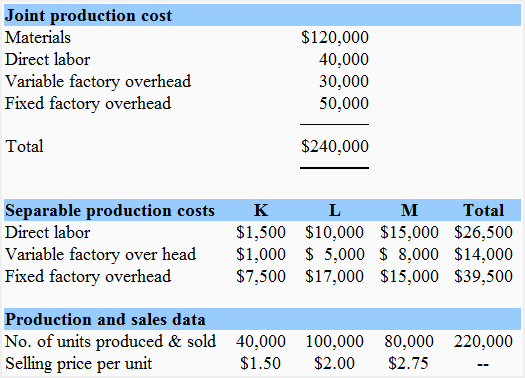
There was no finished goods and work-in-process inventory at the start and end of the year 2019.
Required: Allocate the joint production cost to all three products and compute the gross profit of each product.

* Allocation of joint cost: The joint production cost ($240,000) is 60% of the hypothetical market value ($400,000). The allocation has been made as follows:
- Product K: $50,000 × 0.6 = $30,000
- Product L: $168,000 × 0.6 = $100,800
- Product M: $182,000 × 0.6 = $109,200
** Gross profit The gross profit is equal to ultimate market value less total cost.
- Product K: $60,000 – $40,000 = $20,000
- Product L: $200,000 – $132,800 = $67,200
- Product M: $220,000 – $147,200 = $72,800
Leave a comment Cancel reply

Cost Accounting Exercises with Solutions
Virtual Machine Allocation Using Optimal Resource Management Approach
- Published: 05 July 2024
Cite this article

- Pradeep Singh Rawat ORCID: orcid.org/0000-0002-1081-1822 1
Explore all metrics
Resources are offered to customers on demand in the modern era of computing, communication, and technology. User demand for the resources depends on the service provider and consumer. The optimal assignment of the cloud resources depends on fitness function and resource management technique. In this manuscript, the key focus is to propose a model based on a meta-heuristic evaluation technique. The meta-heuristic evaluation technique provides optimal placement of the virtual machines to the user requests across the globe. The presented framework, elephant heard optimization with neural network (EHO-ANN) outperforms the existing static, dynamic, and nature-inspired techniques. The EHO-ANN is evaluated and analyzed against the Harmony Search Approach, Elephant Heard Optimizer, BAT, and GA cost-aware approach. The evaluation and analysis include the performance metrics, average Execution Time (ms), average Start Time (ms), average utilization, and average Finish Time (ms). The presented model EHO-ANN is validated using two configuration scenarios with 10 virtual machines and 5 virtual machines. The results are generated by fifteen times repeated experimentation which assures the accuracy of the model.
This is a preview of subscription content, log in via an institution to check access.
Access this article
Subscribe and save.
- Get 10 units per month
- Download Article/Chapter or Ebook
- 1 Unit = 1 Article or 1 Chapter
- Cancel anytime
Price includes VAT (Russian Federation)
Instant access to the full article PDF.
Rent this article via DeepDyve
Institutional subscriptions

Data Availability
For data transparency purpose, the data set is available at the link: Parallel Workloads Archive: https://www.cse.huji.ac.il/labs/parallel/workload/ in the public domain.
Greenberg, A., Hamilton, J., Maltz, D. A., & Patel, P. (2008). The cost of a cloud: Research problems in data center networks. ACM SIGCOMM computer communication review, 39 (1), 68–73. https://doi.org/10.1145/1496091.1496103
Article Google Scholar
Kalra, M., & Singh, S. (2015). A review of metaheuristic scheduling techniques in cloud computing. Egyptian Informatics Journal, 16 (3), 275–295. https://doi.org/10.1016/j.eij.2015.07.001
Islam, S., Keung, J., Lee, K., & Liu, A. (2012). Empirical prediction models for adaptive resource provisioning in the cloud. Future Generation Computer Systems, 28 (1), 155–162. https://doi.org/10.1016/j.future.2011.05.027
Núñez, A., Vázquez-Poletti, J. L., Caminero, A. C., Castañé, G. G., Carretero, J., & Llorente, I. M. (2012). iCanCloud: A flexible and scalable cloud infrastructure simulator. Journal of Grid Computing, 10 , 185–209. https://doi.org/10.1007/s10723-012-9208-5
Buyya, R., Ranjan, R., & Calheiros, R. N. (2009). Modeling and simulation of scalable Cloud computing environments and the CloudSim toolkit: Challenges and opportunities. In: 2009 international conference on high performance computing & simulation (pp. 1–11). IEEE. https://doi.org/10.1109/HPCSIM.2009.5192685 .
Huang, X., Li, C., Chen, H., & An, D. (2020). Task scheduling in cloud computing using particle swarm optimization with time varying inertia weight strategies. Cluster Computing, 23 (2), 1137–1147. https://doi.org/10.1007/s10586-019-02983-5
Arabnejad, V., Bubendorfer, K., & Ng, B. (2019). Budget and deadline aware e-science workflow scheduling in clouds. IEEE Transactions on Parallel and Distributed Systems, 30 (1), 29–44. https://doi.org/10.1109/TPDS.2018.2849396
Sharma, M., & Garg, R. (2020). An artificial neural network based approach for energy efficient task scheduling in cloud data centers. Sustainable Computing: Informatics and Systems, 26 , 100373. https://doi.org/10.1016/j.suscom.2020.100373
Lu, Y., & Sun, N. (2019). An effective task scheduling algorithm based on dynamic energy management and efficient resource utilization in green cloud computing environment. Cluster Computing, 22 , 513–520. https://doi.org/10.1007/s10586-017-1272-y
Article MathSciNet Google Scholar
Mansouri, N., & Javidi, M. M. (2020). Cost-based job scheduling strategy in cloud computing environments. Distributed and Parallel Databases, 38 (2), 365–400. https://doi.org/10.1007/s10619-019-07273-y
Shirani, M. R., & Safi-Esfahani, F. (2020). Dynamic scheduling of tasks in cloud computing applying dragonfly algorithm, biogeography-based optimization algorithm and Mexican hat wavelet. The Journal of Supercomputing, 77 (2), 1214–1272.
Gupta, M. K., Jain, A., & Amgoth, T. (2018). Power and resource-aware virtual machine placement for IaaS cloud. Sustainable Computing: Informatics and Systems, 19 , 52–60. https://doi.org/10.1016/j.suscom.2018.07.001
Rawat, P. S., Dimri, P., Kanrar, S., & Saroha, G. P. (2020). Optimize task allocation in cloud environment based on big-bang big-crunch. Wireless Personal Communications, 115 (2), 1711–1754. https://doi.org/10.1007/s11277-020-07651-1
Rawat, P. S., Dimri, P., Gupta, P., & Saroha, G. P. (2021). Resource provisioning in scalable cloud using bio-inspired artificial neural network model. Applied Soft Computing, 99 , 106876. https://doi.org/10.1016/j.asoc.2020.106876
Rawat, P. (2018). A survey and analysis with different resource provisioning strategies in cloud environment. Future Generation Computer Systems, 1 , 339–345.
Google Scholar
Devi, K. L., & Valli, S. (2021). Multi-objective heuristics algorithm for dynamic resource scheduling in the cloud computing environment. The Journal of Supercomputing, 77 (8), 8252–8280. https://doi.org/10.1007/s11227-020-03606-2
Chen, X., & Long, D. (2019). Task scheduling of cloud computing using integrated particle swarm algorithm and ant colony algorithm. Cluster Computing, 22 (2), 2761–2769. https://doi.org/10.1007/s10586-017-1479-y
Chechukwu, A., Li, K., & Shen, Y. (2014). Energy consumption in cloud computing data centers. International Journal of Cloud Computing and Services Science (IJ-CLOSER), 3 (3), 31–48.
Tripathy, B., Dash, S., & Padhy, S. K. (2015). Dynamic task scheduling using a directed neural network. Journal of Parallel and Distributed Computing, 75 , 101–106. https://doi.org/10.1016/j.jpdc.2014.09.015
Agarwal, A., Pirkul, H., & Jacob, V. S. (2003). Augmented neural networks for task scheduling. European Journal of Operational Research, 151 (3), 481–502. https://doi.org/10.1016/S0377-2217(02)00605-7
Sathya Sofia, A., & GaneshKumar, P. (2018). Multi-objective task scheduling to minimize energy consumption and makespan of cloud computing using NSGA-II. Journal of Network and Systems Management, 26 (2), 463–485. https://doi.org/10.1007/s10922-017-9425-0
Tawfeek, M. A., El-Sisi, A. B., Keshk, A. E., & Torkey, F. A. (2014). Virtual machine placement based on ant colony optimization for minimizing resource wastage. In Aboul Ella Hassanien, Mohamed F. Tolba, & Ahmad Taher Azar (Eds.), Advanced machine learning technologies and applications (pp. 153–164). Springer.
https://www.cse.huji.ac.il/labs/parallel/workload/l_sdsc_blue/ .
Parallel workloads archive: https://www.cse.huji.ac.il/labs/parallel/workload/ .
Wang, G. G., Deb, S., & Coelho, L. D. S. (2015, December). Elephant herding optimization. In: 2015 3rd international symposium on computational and business intelligence (ISCBI) (pp. 1–5). IEEE. https://doi.org/10.1109/ISCBI.2015.8
Belgacem, A., Mahmoudi, S., & Ferrag, M. A. (2023). A machine learning model for improving virtual machine migration in cloud computing. The Journal of Supercomputing, 79 (9), 9486–9508. https://doi.org/10.1007/s11227-022-05031-z
Khan, T., Tian, W., Zhou, G., Ilager, S., Gong, M., & Buyya, R. (2022). Machine learning (ML)-centric resource management in cloud computing: A review and future directions. Journal of Network and Computer Applications, 204 , 103405. https://doi.org/10.1016/j.jnca.2022.103405
Ullah, A., & Nawi, N. M. (2023). An improved in tasks allocation system for virtual machines in cloud computing using HBAC algorithm. Journal of Ambient Intelligence and Humanized Computing, 14 (4), 3713–3726. https://doi.org/10.1007/s12652-021-03496-z
Khodaverdian, Z., Sadr, H., Edalatpanah, S. A., & Nazari, M. (2024). An energy aware resource allocation based on combination of CNN and GRU for virtual machine selection. Multimedia Tools and Applications, 83 (9), 25769–25796. https://doi.org/10.1007/s11042-023-16488-2
Sangaiah, A. K., Javadpour, A., Pinto, P., Rezaei, S., & Zhang, W. (2023). Enhanced resource allocation in distributed cloud using fuzzy meta-heuristics optimization. Computer Communications, 209 , 14–25. https://doi.org/10.1016/j.comcom.2023.06.018
Neelakantan, P., & Yadav, N. S. (2023). Proficient job scheduling in cloud computation using an optimized machine learning strategy. International Journal of Information Technology, 15 (5), 2409–2421. https://doi.org/10.1007/s41870-023-01278-8
Moazeni, A., Khorsand, R., & Ramezanpour, M. (2023). Dynamic resource allocation using an adaptive multi-objective teaching-learning based optimization algorithm in cloud. IEEE Access, 11 , 23407–23419. https://doi.org/10.1109/ACCESS.2023.3247639
Çavdar, M. C., Korpeoglu, I., & Ulusoy, Ö. (2024). A utilization based genetic algorithm for virtual machine placement in cloud systems. Computer Communications, 214 , 136–148. https://doi.org/10.1016/j.comcom.2023.11.028
Chen, X., Gu, C., Gao, X., Shen, Y., Sun, Z., & Huang, H. (2024). Virtual Machine Placement for Minimizing Image Retrieval Cost and Communication Cost in Cloud Data Center. IEEE Transactions on Network and Service Management . https://doi.org/10.1109/TNSM.2024.3351148
Booba, B., Anitha, X. J. J., Mohan, C., & Jeyalaksshmi, S. (2024). Hybrid approach for virtual machine allocation in cloud computing. Sustainable Computing: Informatics and Systems, 41 , 100922. https://doi.org/10.1016/j.suscom.2023.100922
Download references
There is no Funding information, there is no funding for research.
Author information
Authors and affiliations.
School of Computing, DIT University, Dehradun, Uttarakhand, India
Pradeep Singh Rawat
You can also search for this author in PubMed Google Scholar
Corresponding author
Correspondence to Pradeep Singh Rawat .
Ethics declarations
Conflicts of interest.
The authors declare that they have no known competing financial interests or personal relationships that could have appeared to influence the work reported in this paper.The authors declare the following financial interests/personal relationships which may be considered as potential competing interests.
Additional information
Publisher's note.
Springer Nature remains neutral with regard to jurisdictional claims in published maps and institutional affiliations.
Rights and permissions
Springer Nature or its licensor (e.g. a society or other partner) holds exclusive rights to this article under a publishing agreement with the author(s) or other rightsholder(s); author self-archiving of the accepted manuscript version of this article is solely governed by the terms of such publishing agreement and applicable law.
Reprints and permissions
About this article
Rawat, P.S. Virtual Machine Allocation Using Optimal Resource Management Approach. Wireless Pers Commun (2024). https://doi.org/10.1007/s11277-024-11465-w
Download citation
Accepted : 30 June 2024
Published : 05 July 2024
DOI : https://doi.org/10.1007/s11277-024-11465-w
Share this article
Anyone you share the following link with will be able to read this content:
Sorry, a shareable link is not currently available for this article.
Provided by the Springer Nature SharedIt content-sharing initiative
- Cloud computing
- Neural network
- Optimization
- SLA (Service Level Agreement)
- Virtual machine
- Find a journal
- Publish with us
- Track your research

COMMENTS
These costs are generally indirect. Since these costs are not directly traceable, an accountant uses their due diligence to allocate these costs in the best possible way. It results in an allocation that could be partially arbitrary, and thus, many refer cost allocation exercise as the spreading of a cost.
Here's what cost allocation would look like for Dave: Direct costs: $5 direct materials + $2 direct labor = $7 direct costs per pair. Indirect costs: Overhead allocation: $5,000 ÷ 3,000 pairs ...
Here's what the process of identifying them looks like. 1. Define Which Costs You Want to Allocate. Begin by calculating the costs you want to allocate in the first place. For example, if you want to allocate the cost of utilities in your office, add them up to get a bigger picture. For the sake of this cost allocation example, let's assume ...
Cost allocation is crucial in finance and accounting. It governs how organizations can allocate costs to the right department or project, guided by software. ... Cost allocation is not merely a financial exercise; it's an art. The strategies we've explored are tools that, when used appropriately, can sculpt a robust financial landscape for ...
LO 10.3 Calculate the cost of goods sold dollar value for B66 Company for the month, considering the following transactions under three different cost allocation methods and using perpetual inventory updating. Provide calculations for last-in, first-out (LIFO).
A cost driver causes a change in the cost associated with an activity. Some examples of cost drivers include the number of machine-hours, the number of direct labor hours worked, the number of payments processed, the number of purchase orders, and the number of invoices sent to customers. Benefits of Cost Allocation. The following are some of ...
Cost allocation is the process that includes identification, aggregation, and assigning all of the costs incurred during the period to the specific object. ... Cost identification is the process of identifying all the costs associated with the cost driver. It's a manual exercise requiring managers to observe the manufacturing process closely ...
1993. There is a billion-dollar-a-year market in strategic cost management consulting services dominated by such firms as Bain & Company, Boston Consulting Group, Booz-Allen & Hamilton, McKinsey etc. Cost Allocation. There are also consulting firms that develop niche groups that are experts in cost allocations for example: Brattle Group ...
Step Two: Allocate Indirect Costs Between Departments or Products. Indirect costs should be allocated between departments, projects, and products based on a fair allocation plan that reflects their use in those areas. For example, suppose your company produces two products, products A and B. In that case, you will need to construct a cost ...
Regardless of the approach taken to allocating common costs, is cost allocation really necessary? Argues that such an exercise may not make any difference to the final outcome ‐ the company's final profit or loss figure. Takes as an example the University of Clemson, USA's system of costing and reporting, and describes the university's ...
The lesson named Cost Allocation: Definition, Terms & Examples takes an in-depth look at this topic. Lesson objectives include: Name the steps of cost allocation. Point out which step requires you ...
Total number of customers who ordered either product are 18,000. This gives us a cost allocation base of $1.1 per customer ($19,700/18,000). A detailed cost assignment is as follows: Manufacturing overheads allocated to Tea & Cofee = $1.1×10,000. Manufacturing overheads allocated to Shakes = $1.1×8,000.
Cost Accounting For Dummies. When cost accounting, the step-down allocation method allows support departments to allocate costs to each other — and ultimately to the operating departments. To accomplish this, the support departments are ranked. The ranking is often based on the percentage of costs that a support department incurs to support ...
The actual results at year-end for the 45 round-trips made were: Variable costs. $60,750 Fixed costs. $36,000. Total. $96,750. Using the dual-rate method, what are the costs allocated to the Dark Chocolate Division and the Milk Chocolate Division when (a) variable costs are allocated using the budgeted rate per round-trip and actual round-trips ...
Research costs in defined categories are allocated in alignment with effort levels of one or more personnel on multiple projects. When goods or services used are proportional to the personnel / effort on the projects. (i.e.; more effort = more supplies) When personnel contributions to multiple projects are consistent over a period of time. and.
Direct costs are the simplest to allocate. Last month, Lisa's Luscious Lemonades produced 50,000 gallons of lemonade and had the following direct costs: Total costs Cost per gallon. Direct materials $142,500 $2.85. Direct labor $37,500 $.75.
What would be the cost per unit (including materials, labor, and overhead) for each product if overhead is allocated to products using direct labor cost as the allocation base? Exercise E Landscape, Inc., is a lawn and garden service. The company originally specialized in serving small residential clients; recently it has started contracting ...
10.5 Summary of Service Department Cost Allocation Methods and Dysfunctional Incentives (unintended consequences) 104. 10. Exercises (Part 1) 105. 10. Exercises and problems (Part 2) - new problems created by Rob Zatulsky, Fall 2022. ... Brief Exercise. Analyzing Costs at Jerry's Ice Cream.
Cost allocation is a financial accounting process that involves assigning various costs incurred by a business to the specific activities or elements used or benefitted from incurring these costs. Its purpose is to accurately represent the financial contribution of different parts of a business, providing insights into areas of efficiency or ...
Chapter 10: Allocation of Service Department Costs. 99. 10.1 Introduction. 100. 10.2 The Direct Method. 101. 10.3 The Step-Down Method. 102. 10.4 The Reciprocal Method. ... Exercises: Set A. Identifying Cost Behavior. Zhang Corporation is trying to identify the cost behavior of the three costs shown. Cost information is provided for six months.
Allocating Direct Costs - Examples . When selecting an appropriate allocation method, the PI needs to exercise judgment and document the selected allocation method for future reference. The following acceptable allocation methods are common approaches used by Principal Investigators: Acceptable Direct Cost Allocation Methods
Exercise-1 (a) Master Company manufactures three products - product 1, product 2 and product 3. The production data of three products for the month of January 2019 is given below: The sales prices or market values at split-off point are given below: During January 2019, Master Company incurred a total joint production cost of $27,000. […]
Cost Accounting Exercises with Solutions are a set of questions with solutions for practice accounting and finance students.
Dynamic asset allocation is another flexible strategy where the portfolio mix is adjusted continually based on market conditions. Unlike tactical allocation, which focuses on short-term opportunities, dynamic allocation involves ongoing adjustments to reduce risk during downturns and increase exposure during market upswings.
Resources are offered to customers on demand in the modern era of computing, communication, and technology. User demand for the resources depends on the service provider and consumer. The optimal assignment of the cloud resources depends on fitness function and resource management technique. In this manuscript, the key focus is to propose a model based on a meta-heuristic evaluation technique ...